TODO:
get the unit renaming in the columns working with regex in
ac_representation_toolfigure out why the sym and symbolic all-pass filter diverge from each other
create a table of low-high pass vs rc & rl
look into ngspice internals and really verify that there are no equivalencies to dc internals with .ac sims
Most likely will do this in another section further down the road
add filter design tool and filter circuit generation tool; see isbn 978-0-387-92766-4 and things like cauer network tf implimentation
discuss L->C passive conversion
from skidl.pyspice import *
#can you say cheeky
import PySpice as pspice
#becouse it's written by a kiwi you know
import lcapy as kiwi
import numpy as np
import pandas as pd
import matplotlib.pyplot as plt
import sympy as sym
from IPython.display import YouTubeVideo, display
import traceback
import warnings
WARNING: KICAD_SYMBOL_DIR environment variable is missing, so the default KiCad symbol libraries won't be searched.
#import dc code from parral folder
import sys
sys.path.insert(1, '../DC_1/')
from DC_1_Codes import get_skidl_spice_ref
#from AC_2_Codes import
sym.init_printing()
#notebook specific loading control statements
%matplotlib inline
#tool to log notebook internals
#https://github.com/jrjohansson/version_information
%load_ext version_information
%version_information skidl, PySpice,lcapy, sympy, numpy, matplotlib, pandas, scipy
| Software | Version |
|---|---|
| Python | 3.7.6 64bit [GCC 7.3.0] |
| IPython | 7.12.0 |
| OS | Linux 4.19.104 microsoft standard x86_64 with debian bullseye sid |
| skidl | 0.0.31.dev0 |
| PySpice | 1.4.3 |
| lcapy | 0.75.dev0 |
| sympy | 1.6.2 |
| numpy | 1.18.1 |
| matplotlib | 3.3.0 |
| pandas | 1.1.4 |
| scipy | 1.4.1 |
| Thu Jan 28 00:37:57 2021 MST | |
Basic Passive Filters¶
In this section, we will construct and look at the basic passive analog filters constructed of RLC elements only. For now, we will just develop an ac equivalent tool to dc_ease that was in the last chapter. As well as some basic data manipulation, plotting tool, and classes for the RLC primitive filters. For advanced tools filter analysis will be developed later in this chapter in section asdlkjfaljdfkj where then we can compare not only the SPICE simulation data but also the SPICE generated Pole-Zero Transfer function and the theoretical transfer function to each other in greater detail.
The RC Low Pass Filter¶¶
The RC filter is a first-order single-pole filter. Where the pole is realized physically by a shunt capacitor. For more technical details about an RC low pass filter consult the YT video by ALL ABOUT ELECTRONICS “RC Low Pass Filter Explained” that serves as the example source below
The low pass RC filter from ALL ABOUT ELECTRONICS “RC Low Pass Filter Explained” @~ 8:35min¶
YouTubeVideo('_2L0l-E1Wx0', width=500, height=400, start=515)
RC Low Pass Filter Subcircuit container class¶
The class below is the first in a series of classes developed in this section to create and store information about the filter primitive under test. For each of these primitives we will create a class that does three things:
stores the filter element values in the class initiation method
generates the filter and its elements inside a SKiDl subcircuit to then included in the circuit under design
provides a schematic representation method of the filter being constructed by this class via lcapy
provides the transfer function and two-port representation of the filter in sympy via its own methods by using the lcapy schematic
We see how this is done with the RC Low Pass filter first below
#%%writefile -a AC_2_Codes.py
#chapteer 2 section 2 rc_lowpass filter class
#class with lcapy and skidl subcircuit to create an RC lowpass filter
class rc_lowpass():
"""
holding class for SkiDl subcircuit and lcapy schematic of a
lowpass RC filter primitive
"""
def __init__(self, subcirc_ref=None, C_value=1@u_F, R_value=1@u_Ohm):
"""
Args:
subcirc_ref (str): reference to use for the base of the internal elements
C_value (float; 1@u_F; Farads): the capacitance in farads for the RC capacitive element
R_value (float; 1@u_Ohm; Ohms): the resistance in ohms for the RC resistive element
Returns:
None
TODO:
-add assertions
"""
#add assertions
self.subcirc_ref=subcirc_ref
self.C_value=C_value
self.R_value=R_value
@subcircuit
def SKiDl(self, term_0, term_1, term_2, term_3, return_elements=False):
"""
Terminals:
term_0, term_1, term_2, term_3
Terminals are defined via:
```
Left_Termanals - RC_Lowpass - Right_Termanals
+----+
Postive V_i term_0-|0 2|-term_2 Postive V_o
Negtive V_i term_1-|1 3|-term_3 Negtive V_o
+----+
```
Args:
return_internls (bool; False): If True return out the internal Voltage Source,
and Resistance objects in this package
Returns:
Returns elements to circuit RC lowpass filter part element object and if `return_internls`
is True will return the internal voltage and resistance objects in that order
"""
if self.subcirc_ref!=None:
Cref={'ref':f'C_{self.subcirc_ref}'}
Rref={'ref':f'R_{self.subcirc_ref}'}
else:
Cref={}
Rref={}
self.c=C(value=self.C_value, **Cref)
self.r=R(value=self.R_value, **Rref)
self.r[1, 2]+=term_0, self.c['p']
self.c['p', 'n']+=term_2, term_3
if return_elements:
return self.c, self.r
def lcapy_self(self, draw_me=True, with_values=True):
"""
Creates a lcapy schematic of this classes filter that
can be used for amongst other things: draw a basic schematic
of this class filter, extract the transfer function,
exstract the 2Port Repersntation
Args:
draw_me (bool): will draw a schematic of this classes filter schematic
with_values (bool): will push the filters element values into
the resulting lcapy circuit object in place of abstract simply variables
Return:
the lcapys circuit object is stored in `self.schematic` and will
have abstract sympy variable for the elements if `with_values` is False
and will draw the schematic of just this classes filter if `draw_me` is True
TODO:
- get the Vin statement into the schematic
"""
self.with_values=with_values
self.schematic=kiwi.Circuit()
self.schematic.add('W 1 1_1; right=2')
self.schematic.add('W 0 0_1; right')
#self.schematic.add('P1 0 1; down, v=V_i')
self.schematic.add('R 0_1 2_1; right')
self.schematic.add('C 2_1 1_1; down')
self.schematic.add('W 2_1 2; right=1.5')
self.schematic.add('W 1_1 3; right=1.5')
self.schematic.add('P2 2 3; down, v=V_o')
if with_values:
self.schematic=self.schematic.subs({'R':self.R_value, 'C':self.C_value})
if draw_me:
self.schematic.draw()
def get_tf(self, with_values=True, ZPK=True):
"""
will extract the symbolic transfer function for this filter
Args:
with_values (bool): will push the filters element values into
the resulting lcapy circuit object in place of abstract sympy variables
ZPK (bool): if True will try to return the TF in zero-pole-gain form
else will try to return the TF in canonical form
where the unity coefficient is the highest power of the denominator
"""
self.lcapy_self(draw_me=False, with_values=with_values)
self.tf=self.schematic.transfer(0, 1, 2, 3)
if ZPK:
return self.tf.ZPK()
else:
return self.tf.canonical()
def get_twoPort(self, network_rep='Y', with_values=True):
"""
Gets the 2Port network representation of this filter.
The 2Port representation can be controlled
Args:
network_rep (str; 'Y'): control string for what
representation is used to choose from:
'Z': two-port Z-parameters matrix
'Y': two-port Y-parameters matrix
'H': two-port H-parameters matrix
'G': two-port G-parameters matrix
'ABCD': two-port A-parameters matrix
'invABCD': two-port B-parameters matrix
'S': two-port S-parameters matrix
'T': two-port T-parameters matrix
"""
self.lcapy_self(draw_me=False, with_values=with_values)
#create an action dict to get the 2P rep
rep_actions={
'Z':lambda x: x.Zparams(0, 1, 2, 1),
'Y':lambda x: x.Yparams(0, 1, 2, 1),
'H':lambda x: x.Hparams(0, 1, 2, 1),
'G':lambda x: x.Gparams(0, 1, 2, 1),
'ABCD':lambda x: x.Aparams(0, 1, 2, 1),
'invABCD':lambda x: x.Bparams(0, 1, 2, 1),
'S':lambda x: x.Sparams(0, 1, 2, 1),
'T':lambda x: x.Tparams(0, 1, 2, 1),
}
assert network_rep in rep_actions.keys(), f'`{network_rep}` is not 2Port rep'
return rep_actions[network_rep](self.schematic)
In the method for the subcircuit SKiDl above we referenced a port-terminal convention from a library scikit-rf. This is the main python library for S-parameter analysis and primitive rf circuit design in the Python scientific ecosystem. Where we will interact with it at length in the following sections but for now let’s just get in the habit of using their port-terminal convention since we are coding all this up in python
Below we instantiate the filter to the values found in the reference example above and draw it
#instatate the rc_lowpass filter to
lowpassF=rc_lowpass(C_value=.1@u_uF, R_value=1@u_kOhm)
lowpassF.lcapy_self()
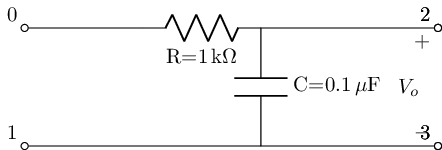
Nest using lcapy we can use the circuit we created in rc_lowpass.lcapy_self to then extract the voltage transfer function coming from the Port 0 & 1 Terminals to the Port 2 & 3 Terminals. Where the method has been abstracted such that it can be called to just get the symbolic equation or get the symbolic equation with the values of this particular instance substituted into the symbolic expression.
#get this filters abstract transfer function
lowpassF.get_tf(with_values=False)
#get this filters transfer function
lowpassF.get_tf(with_values=True)
and finally, we will now use the lowpass filter in its primary utilization as part of a circuit to be simulated with SPICE.
reset()
#create the nets
net_in=Net('In'); net_out=Net('Out');
#create a 1V AC test source and attache to nets
vs=SINEV(ac_magnitude=1@u_V); vs['p', 'n']+=net_in, gnd
#attaceh term_0 to net_in and term_2 to net_out per scikit-rf convention all
#other terminals are grounded
lowpassF.SKiDl(net_in, gnd, net_out, gnd)
circ=generate_netlist()
print(circ)
.title
V1 In 0 DC 0V AC 1V 0.0rad SIN(0V 1V 50Hz 0s 0Hz)
C1 Out 0 0.1uF
R1 In Out 1kOhm
No errors or warnings found during netlist generation.
making ac_ease¶¶
In the last chapter, we developed a class dc_ease to make running the .dc SPICE simulation more automated. Here we will develop an analogies class ac_ease to automate the .ac simulation. There are some differences thou. For one with .dc simulation, we could sweep over any variable (I still need to fix pyspice to do that); whereas we learned in the last section that .ac simulation only allows us to sweep the operating frequency of all our sources simultaneously and observe the response of the circuit to each frequency in terms of Fourier transform terms. The second thing is that .dc simulations allowed us to access a plethora of circuit elements’ internal parameters to record things such as current and power without having to add SPICE ammeter all over the place. While .ac does not have quite that support in ngspice (see typically chapter 31 “Model and Device Parameters” in the ngspice manual). So we are going to forgo do internal parameters in ac_ease.
Also, in the last section, we just used the “linear” sweep capability of an ac simulation. However, AC simulations are more commonly done via logarithm sweeps. This is akin to np.logspace, however, unlike NumPy’s logspace, we till .ac what the starting and stop are and how many samples we want per decade. And then there is the less used ” octave ” sampling scheme where there is no numpy kin. Octave takes the starting frequency, say 1kHz, and then computes the doubles of it (think octaves in music) and then samples within that doubling. So 1kHz doubles to 2kHz and so on till the stop frequency is reached while getting n samples within each double via the “number_of_points” argument in the .ac simulation control.
#%%writefile -a AC_2_Codes.py
#chapteer 2 section 2 ac_ease class
#class to perform .ac simulations with a bit more grace
class ac_ease():
"""
Class to perform AC (.ac) SPICE simulation with some grace;
currently limited to what pyspice and ngspice support
TODO:
- independent current sources can have their AC current measured via
`@I<name>[acreal]` & `@I<name>[acrimag]` not shure if this is usefull
also trying via the sensitivity
- do some serious testing with ngspice directly to verify that internal
parameters are as limited as they appear to be with .ac
"""
def __init__(self, circ_netlist_obj):
"""
Class to perform AC (.ac) SPICE simulation with some grace
Args:
circ_netlist_obj (pyspice.Spice.Netlist.Circuit): the Netlist circuit produced
from SKiDl's `generate_netlist()`
Returns:
creates a table to control the ac sweep `self.fsweep_DF`
this table will still need to be filled out before a simulation can be run with `self.do_ac_sim`
can be filled out manually or with the helper method `self.ac_sweep_setup`
"""
self.circ_netlist_obj=circ_netlist_obj
self._build_table()
#dic of allowed AC sweep types
self.allowed_steptypes_map={'linear':'lin', 'decade':'dec', 'octave': 'oct'}
def _build_table(self):
"""
protected method to create `self.fsweep_DF` dataframe that stores the controls for the ac simulation
TODO:
-when pyspice accepts more things to sweep add them below
"""
self.fsweep_DF=pd.DataFrame(columns=['Start_freq', 'Stop_Freq', 'SamplingInc', 'StepType'])
self.fsweep_DF.at[len(self.fsweep_DF)]=[.1@u_Hz, 120@u_GHz, 10, 'decade']
def ac_sweep_setup(self, Start_freq, Stop_Freq, SamplingInc, StepType, display_table=False):
"""
Helper method to create the `self.fsweep_DF` to control the ac simulation
Args:
Start_freq (Hertz): starting frequency in Hertz of the ac simulation, must be less than `Stop_Freq` and can
only be zero if `StepType='linear'`
Stop_Freq (Hertz): stoping frequency in Hertz of the ac simulation, must be greater than `Start_freq`
SamplingInc (int): number of samples per StepType interval
StepType (string): string control for the ac simulation Step type.
must be 'linear' (self-explanatory), 'decade' (log base 10 sampling interval),
or 'octave' (starting frequency times 2**n to create sample space a double of the starting frequency
so that samples are pulled from 2**(n-1) and 2**(n) times the starting frequency)
display_table (bool; False): when true will display the generated `self.fsweep_DF` below
this method call in a jupyter notebook like environment
TODO:
-add display action
"""
#check for allowed step types
assert StepType in self.allowed_steptypes_map.keys(), f"{StepType} is not allowed"
#force start to non zero if sweep not linear
if StepType != 'linear':
if float(Start_freq)==0:
warnings.warn('"linear" is only sweep type that can start at 0Hz,\n setting starting frequancy to 1e-1Hz')
Start_freq=1e-1@u_Hz
#check that stop frequency is greater than start
assert Stop_Freq>Start_freq, 'Stop frequency must be greater then starting frequency'
self.fsweep_DF.at[0]=[Start_freq, Stop_Freq, SamplingInc, StepType]
if display_table:
display(self.fsweep_DF)
def _make_sim_control(self):
"""
Internal method to extract the row information to the .ac pyspice call arguments
Will raise a warning if the simulation start frequency is 0Hz for non-linear frequency sampling and
then set the start frequency to .1Hz
Args:
NONE
Returns:
`self.ac_control` what is feed into the .ac to do the simulation over a frequency
"""
#check the control table struct
assert (self.fsweep_DF.columns==['Start_freq', 'Stop_Freq', 'SamplingInc', 'StepType']).all(), 'Contorl Table Column structer has been altered'
#will probably change this down the road
assert len(self.fsweep_DF)==1, 'there should only be one entry in the control table'
#check the sweep type
self.fsweep_DF['StepType'][0] in self.allowed_steptypes_map.keys(), f"{self.fsweep_DF['StepType'][0]} is not allowed"
#check that stop frequency is greater than start
assert self.fsweep_DF.at[0, 'Stop_Freq']>self.fsweep_DF.at[0, 'Start_freq'], 'Stop freqauncy must be grater then starting freauncy'
#force start to non zero if sweep not linear
if self.fsweep_DF['StepType'][0] != 'linear':
if float(self.fsweep_DF['Start_freq'][0])==0:
warnings.warn('"linear" is only sweep type that can start at 0Hz,\n setting starting frequancy to 1e-1Hz')
self.fsweep_DF.at[0, 'Start_freq']=1e-1@u_Hz
self.ac_control={
'start_frequency':self.fsweep_DF.at[0, 'Start_freq'],
'stop_frequency':self.fsweep_DF.at[0, 'Stop_Freq'],
'number_of_points':self.fsweep_DF.at[0, 'SamplingInc'],
'variation': self.allowed_steptypes_map[self.fsweep_DF.at[0, 'StepType']]
}
def do_ac_sim(self):
"""
Does a standard Branch and Node .ac simulation for the single filled out row in `self.fsweep_DF`
Args:
None
Returns:
raw results are stored in `self.ac_vals`, processed results are automatically stored in
`self.ac_resultsNB_DF` via `self.record_ac_nodebranch`
"""
self._make_sim_control()
self.sim=self.circ_netlist_obj.simulator()
self.ac_vals=self.sim.ac(**self.ac_control)
self.record_ac_nodebranch()
def record_ac_nodebranch(self):
"""
Helper method to put .ac node branch results into a dataframe where the index is the
sweep frequency used in the simulation
Args:
None
Returns:
`self.ac_resultsNB_DF` which is a pandas dataframe with the index being the sweep frequency
and the columns being the node voltages and branch currents from any available voltage sources
TODO:
look into getting the current in any current sources
"""
self.ac_resultsNB_DF=pd.DataFrame(index=self.ac_vals.frequency.as_ndarray())
self.ac_resultsNB_DF.index.name='freq[Hz]'
#get the node voltages
for n in self.circ_netlist_obj.node_names:
if n=='0':
continue
self.ac_resultsNB_DF[n+'_[V]']=self.ac_vals[n].as_ndarray()
#get the current from any voltage source
for cm in self.circ_netlist_obj.element_names:
if 'V'==cm[0]:
self.ac_resultsNB_DF[cm+'_[A]']=-self.ac_vals[cm].as_ndarray()
#instainte the simulation from the circuit
ac_sweep=ac_ease(circ)
#setup the simulation parameter with the helper method
ac_sweep.ac_sweep_setup(0, 100@u_MHz, 10, 'decade', True)
/home/iridium/anaconda3/lib/python3.7/site-packages/ipykernel_launcher.py:76: UserWarning: "linear" is only sweep type that can start at 0Hz,
setting starting frequancy to 1e-1Hz
| Start_freq | Stop_Freq | SamplingInc | StepType | |
|---|---|---|---|---|
| 0 | 0.1 Hz | 100 MHz | 10 | decade |
ac_sweep.do_ac_sim()
ac_sweep.ac_resultsNB_DF
| In_[V] | Out_[V] | V1_[A] | |
|---|---|---|---|
| freq[Hz] | |||
| 1.000000e-01 | 1.000000+0.000000j | 1.000000-0.000063j | 3.947842e-12+6.283185e-08j |
| 1.258925e-01 | 1.000000+0.000000j | 1.000000-0.000079j | 6.256907e-12+7.910062e-08j |
| 1.584893e-01 | 1.000000+0.000000j | 1.000000-0.000100j | 9.916529e-12+9.958178e-08j |
| 1.995262e-01 | 1.000000+0.000000j | 1.000000-0.000125j | 1.571664e-11+1.253660e-07j |
| 2.511886e-01 | 1.000000+0.000000j | 1.000000-0.000158j | 2.490920e-11+1.578265e-07j |
| ... | ... | ... | ... |
| 3.981072e+07 | 1.000000+0.000000j | 0.000000-0.000040j | 1.000000e-03+3.997791e-08j |
| 5.011872e+07 | 1.000000+0.000000j | 0.000000-0.000032j | 1.000000e-03+3.175559e-08j |
| 6.309574e+07 | 1.000000+0.000000j | 0.000000-0.000025j | 1.000000e-03+2.522436e-08j |
| 7.943282e+07 | 1.000000+0.000000j | 0.000000-0.000020j | 1.000000e-03+2.003642e-08j |
| 1.000000e+08 | 1.000000+0.000000j | 0.000000-0.000016j | 1.000000e-03+1.591549e-08j |
91 rows × 3 columns
making a basic ac data conversion tool¶
As we learned in the last section since the returns of an AC simulation are complex values we have to represent the values in order to just plot the values. The following class has methods that will allow us to pass in the raw results of the AC simulation and then perform reinterpretation of the values as needed
#%%writefile -a AC_2_Codes.py
#chapteer 2 section 2 ac_representation_tool class
#class that converts dataframe of raw ac complex data to veries complex
#repsentations
class ac_representation_tool:
"""
Class to take a dataframe with AC simulation complex value data and
represent it in various ways. raw data should come from `ac_ease.ac_resultsNB_DF`
TODO:
-get the unit renaming in the columns working with regex
"""
def __init__(self, ac_sim_raw_DF):
"""
pull in the data
Args:
ac_sim_raw_DF (pandas dataframe): pandas dataframe of raw data from AC simulation
preferbyly from `ac_ease.ac_resultsNB_DF`, index must be the simulation
frequency and columns must be the complex data
Returns:
None
TODO:
broaden complex assertin to include np.complex128
"""
#write asserts for ac_sim_DF
assert repr(type(ac_sim_raw_DF))=="<class 'pandas.core.frame.DataFrame'>", '`ac_sim_raw_DF` must be a dataframe'
#check that all columns from raw data are complex
assert (ac_sim_raw_DF.dtypes==np.complex64).all() or (ac_sim_raw_DF.dtypes==np.complex128).all(), 'Raw data must be complex from AC sim'
self.ac_sim_raw_DF=ac_sim_raw_DF
def make_real_imag(self):
"""
Method to create a real and image version of the raw data
Args: None
Returns:
real values are stored in `self.ac_sim_real_DF`; and
imaginary values are stored in `self.ac_sim_imag_DF`
"""
self.ac_sim_real_DF=self.ac_sim_raw_DF.apply(np.real, axis=0)
self.ac_sim_imag_DF=self.ac_sim_raw_DF.apply(np.imag, axis=0)
def make_mag_phase(self, mag='dB', char_res=50, deg=True, phase_unwrap=True):
"""
Method to make generate the various magnitude and phase representation of the complex data
Args:
mag (string, "dB"): control statement to specify the representation of the generated
magnitude data; right now only 'dB' and 'abs' are supported
char_res (float; 50; ohms): the characteristic impedance for magnitude representation calculations; not
implemented at the moment
deg (bool; True): bool control statement to represent the phase data in degrees if True; else in radians
phase_unwrap (bool; True): when True and `deg` is True will represent the degrees in phased unwrapped
Returns:
magnitude data is stored in `self.ac_sim_mag_DF` and phase data is stored in `self.ac_sim_phase_DF`
TODO:
-complete all of the magnitude conversions
"""
#deal with the cacophony of magnitudes
mag_conversions={
'dB': lambda x: 10*np.log10(np.abs(x)) if x.name in ['[W]', '[VAR]', '[VA]'] else 20*np.log10(np.abs(x)),
'abs': lambda x: np.abs(x)
}
#check the input
assert mag in mag_conversions.keys(), f'{mag} is not a known magnitude repsentation'
self.ac_sim_mag_DF=self.ac_sim_raw_DF.apply(mag_conversions[mag], axis=0)
#redo the column name units
#get down with the regex to really do this
if mag in ['dB']:
self.ac_sim_mag_DF.rename(columns={i:i+'[dB]' for i in self.ac_sim_mag_DF.columns}, inplace=True)
#deal with the phase
if (deg==True) and (phase_unwrap==True):
#phase unwrapped lambda function
angle_phase_unwrap= lambda x: np.rad2deg(np.unwrap(np.angle(x)))
self.ac_sim_phase_DF=self.ac_sim_raw_DF.apply(angle_phase_unwrap, axis=0)
else:
self.ac_sim_phase_DF=self.ac_sim_raw_DF.apply(np.angle, axis=0, deg=deg)
#realy need that stupid regex working
if deg:
self.ac_sim_phase_DF.rename(columns={i:i+'[deg]' for i in self.ac_sim_phase_DF.columns}, inplace=True)
else:
self.ac_sim_phase_DF.rename(columns={i:i+'[rads]' for i in self.ac_sim_phase_DF.columns}, inplace=True)
ac_rep_tool=ac_representation_tool(ac_sweep.ac_resultsNB_DF)
ac_rep_tool.make_real_imag()
ac_rep_tool.ac_sim_real_DF
| In_[V] | Out_[V] | V1_[A] | |
|---|---|---|---|
| freq[Hz] | |||
| 1.000000e-01 | 1.0 | 1.000000e+00 | 3.947842e-12 |
| 1.258925e-01 | 1.0 | 1.000000e+00 | 6.256907e-12 |
| 1.584893e-01 | 1.0 | 1.000000e+00 | 9.916529e-12 |
| 1.995262e-01 | 1.0 | 1.000000e+00 | 1.571664e-11 |
| 2.511886e-01 | 1.0 | 1.000000e+00 | 2.490920e-11 |
| ... | ... | ... | ... |
| 3.981072e+07 | 1.0 | 1.598234e-09 | 1.000000e-03 |
| 5.011872e+07 | 1.0 | 1.008417e-09 | 1.000000e-03 |
| 6.309574e+07 | 1.0 | 6.362683e-10 | 1.000000e-03 |
| 7.943282e+07 | 1.0 | 4.014581e-10 | 1.000000e-03 |
| 1.000000e+08 | 1.0 | 2.533030e-10 | 1.000000e-03 |
91 rows × 3 columns
ac_rep_tool.make_mag_phase()
ac_rep_tool.ac_sim_mag_DF
| In_[V][dB] | Out_[V][dB] | V1_[A][dB] | |
|---|---|---|---|
| freq[Hz] | |||
| 1.000000e-01 | 0.0 | 0.000000 | -144.036407 |
| 1.258925e-01 | 0.0 | 0.000000 | -142.036407 |
| 1.584893e-01 | 0.0 | 0.000000 | -140.036407 |
| 1.995262e-01 | 0.0 | 0.000000 | -138.036407 |
| 2.511886e-01 | 0.0 | 0.000000 | -136.036407 |
| ... | ... | ... | ... |
| 3.981072e+07 | 0.0 | -87.963600 | -60.000000 |
| 5.011872e+07 | 0.0 | -89.963600 | -60.000000 |
| 6.309574e+07 | 0.0 | -91.963593 | -60.000000 |
| 7.943282e+07 | 0.0 | -93.963593 | -60.000000 |
| 1.000000e+08 | 0.0 | -95.963593 | -60.000000 |
91 rows × 3 columns
Making a complex representation plotting templet¶¶
Here we are going to make a class the store plot templets for the 3+1 major representations of complex values:
Bode Plot with Magnitude and Phase on the same plot: The Bode plot is the most widely used plot of complex data that is parametric to the frequency which we use as the x-axis. This is one of two standard variations of the Bode plot where the Magnitude and Phase is plotted on the same graph using twin axis
Bode Plot with Magnitude and Phase on the separate plots: In this version of the Bode plot the x-axis is still the frequency and there are two subplots sharing the same x-axis with the top plot being the magnitude plot and the bottom being the phase
Nichols Plot: This is a parametric plot where the x-axis and the phase and the y-axis is the magnitude and direction is indicated by an arrow along the line showing the direction of frequency increase. This plot is used more in Feedback and Control system design.
Nyquist Plot: This is a parametric plot where the x-axis and the real part and the y-axis is the imaginary part and direction is indicated by an arrow along the line showing the direction of frequency increase. This plot is used more in Feedback and Control system design.
This class contains templets since an existing matplotlib axis can be passed through them to then include them in more advanced plots with additional information being able to be added to the axis. Or these plot methods can be called without any axis passed to them to then generate a basic plot
#%%writefile -a AC_2_Codes.py
#chapteer 2 section 2 eecomplex_plot_templets class
#class that stores templets plots for most common complex rep plots
class eecomplex_plot_templets():
"""
Class that stores basic/common Electrical Engineering Complex value
representation plots that may be used stand-alone or as templets in other plots
with refinements
"""
def __init__(self):
pass
def bode_plot_one_templet(self, freq_data, mag_data, phase_data, ax=None, title=''):
"""
Templet plot to make a Bode plot with Magnitude and Phase all in one
graph using a twinx.
Args:
freq_data (numpy array or pandas series; Hz): the sampling frequency
mag_data (numpy array or pandas seres; dB): the magnitude data in decibels
phase_data (numpy array or pandas series; deg unwrapped): the phase data in degrees unwrapped
ax (matplotlib axis; None): If left None will create a new plot, else must
be a matplotlib subplot axis to be added to
title (str; ''): Subplot title string
Returns:
Returns a bode plot, and if an axis was passed to `ax` will be modified
with how to plot the magnitude
TODO:
- figure out how to return the `ax_phase` generated internally
- add x,y scale control
"""
assert len(freq_data)==len(mag_data)==len(phase_data), 'freq_data, mag_data, phase_data, must all be the same length'
if ax!=None:
assert repr(type(ax))=="<class 'matplotlib.axes._subplots.AxesSubplot'>", 'ax must be a matplotlib axis'
ax_mag=ax or plt.gca()
#fig, ax_mag=plt.subplots()
ax_phase=ax_mag.twinx()
ax_mag.semilogx(freq_data, mag_data, label='mag')
ax_phase.semilogx(freq_data, phase_data, color='green', linestyle='--', label='phase')
ax_mag.set_xlabel('frequancy [Hz]')
ax_mag.set_ylabel('[dB]')
ax_phase.set_ylabel('[deg]')
ax_mag.grid()
#make a single legend
handles, labels = [(a + b) for a, b in zip(ax_mag.get_legend_handles_labels(), ax_phase.get_legend_handles_labels())]
ax_phase.legend(handles, labels)
if title!='':
title=' of '+title
ax_mag.set_title(f'Bode Plot{title}')
def bode_plot_two_templet(self, freq_data, mag_data, phase_data,
axs=None, title=''):
"""
Templet plot to make a Bode plot with Magnitude and Phase in two separate subplots
with shared x-axis
Args:
freq_data (numpy array or pandas series; Hz): the sampling frequency
mag_data (numpy array or pandas seres; dB): the magnitude data in decibels
phase_data (numpy array or pandas series; deg unwrapped): the phase data in degrees unwrapped
axs (list of matplotlib axis; None): If left None will create a new plot, else must
be a list of matplotlib subplots axis to be added to where the first entry
will be the magnitude axis, and the second will be the phase axis
title (str; ''): Subplot title string
Returns:
Returns a bode plot, and if an axis was passed to `ax` will be modified
with how to plot the magnitude
TODO:
- add x,y scale control
"""
assert len(freq_data)==len(mag_data)==len(phase_data), 'freq_data, mag_data, phase_data, must all be the same length'
if axs==None:
fig, [ax_mag, ax_phase]=plt.subplots(nrows=2, sharex=True)
else:
assert len(axs)==2, 'there should only be two elements in axs'
for i, ax in enumerate(axs):
assert repr(type(ax))=="<class 'matplotlib.axes._subplots.AxesSubplot'>", f"element {i} in axs was not a matplotlib axis"
ax_mag=axs[0]; ax_phase=axs[1]
ax_mag.get_shared_x_axes().join(ax_mag, ax_phase)
#fore the two axes to share x
ax_mag.xaxis.set_tick_params(which='both', labelbottom=True)
ax_mag.semilogx(freq_data, mag_data, label='mag')
ax_phase.semilogx(freq_data, phase_data, color='green', linestyle='--', label='phase')
ax_mag.set_ylabel('[dB]')
ax_phase.set_ylabel('[deg]')
ax_mag.grid()
ax_phase.grid()
#style the x-axis for both subplots so it's between the two
ax_phase.set_xlabel('frequancy [Hz]')
ax_phase.xaxis.set_label_position('top')
ax_phase.xaxis.set_ticks_position('top')
ax_phase.tick_params(labelbottom=False,labeltop=True)
if title!='':
title=' of '+title
ax_mag.set_title(f'Bode Plot{title}');
plt.tight_layout()
def nichols_plot_templet(self, mag_data, phase_data, ax=None, title=''):
"""
Templet plot to make a Nichols plot with magnitude in the y-axis and
phase in the x-axis, with a counter arrow showing the parametric direction
Args:
mag_data (numpy array or pandas seres; dB): the magnitude data in decibels
phase_data (numpy array or pandas series; deg unwrapped): the phase data in degrees unwrapped
ax (matplotlib axis; None): If left None will create a new plot, else must
be a matplotlib subplot axis to be added to
title (str; ''): Subplot title string
Returns:
Returns a Nichols plot, and if an axis was passed to `ax` will be modified
with the Nichols plot
TODO:
- add x,y scale control
"""
assert len(mag_data)==len(phase_data), 'mag_data and phase_data, must all be the same length'
if ax!=None:
assert repr(type(ax))=="<class 'matplotlib.axes._subplots.AxesSubplot'>", 'ax must be a matplotlib axis'
ax=ax or plt.gca()
ax.plot(phase_data, mag_data)
line=ax.get_lines()[0]
eecomplex_plot_templets.add_arrow(line)
#xlim
xmin=phase_data.min()*1.1; xmax=phase_data.max()*1.1
if -1*xmax<xmin:
xmin=-1*xmax
if -1*xmin>xmax:
xmax=-1*xmin
ax.set_xlim(xmin, xmax)
ax.set_xlabel('[deg]'); ax.set_ylabel('[dB]')
ax.grid()
#ax.axhline(0, linestyle='--', linewidth=2.0, color='black')
ax.axvline(0, linestyle='--', linewidth=2.0, color='black')
if title!='':
title=' of '+title
ax.set_title(f'Nichols Plot{title}');
def nyquist_plot_templet(self, real_data, imag_data, ax=None, title=''):
"""
Templet plot to make a Nyquist plot with imaginary in the y-axis and
real in the x-axis, with a counter arrow showing the parametric direction
Args:
real_data (numpy array or pandas series): the real data
imag_data (numpy array or pandas series): the imaginary data
ax (matplotlib axis; None): If left None will create a new plot, else must
be a matplotlib subplot axis to be added to
title (str; ''): Subplot title string
Returns:
Returns a Nyquist plot, and if an axis was passed to `ax` will be modified
with the Nyquist plot
TODO:
- add x,y scale control
"""
assert len(real_data)==len(imag_data), 'real_data and imag_data, must all be the same length'
if ax!=None:
assert repr(type(ax))=="<class 'matplotlib.axes._subplots.AxesSubplot'>", 'ax must be a matplotlib axis'
ax=ax or plt.gca()
ax.plot(real_data, imag_data)
line=ax.get_lines()[0]
eecomplex_plot_templets.add_arrow(line)
#xlim
xmin=real_data.min()*1.1; xmax=real_data.max()*1.1
if -1*xmax<xmin:
xmin=-1*xmax
if -1*xmin>xmax:
xmax=-1*xmin
ax.set_xlim(xmin, xmax)
#ylim
ymin=imag_data.min()*1.1; ymax=imag_data.max()*1.1
if -1*ymax<ymin:
ymin=-1*ymax
if -1*ymin>ymax:
ymax=-1*ymin
ax.set_ylim(ymin, ymax)
ax.set_xlabel('Real'); ax.set_ylabel('Imag')
ax.grid()
ax.axhline(0, linestyle='--', linewidth=2.0, color='black')
ax.axvline(0, linestyle='--', linewidth=2.0, color='black')
if title!='':
title=' of '+title
ax.set_title(f'Nyquist Plot{title}');
@staticmethod
def add_arrow(line, positions=None, num_positions=4, direction='right', size=15, color=None):
"""
add an arrow to a line axis in the direction of the parametric data.
line: Line2D object
positions: list or array of index positions to draw an arrow(s) at; if None will draw at least one arrow
num_positions: int; then number arrows to draw along the length of the line; if 1 will draw at the mean
direction: 'left' or 'right'
size: the size of the arrow in font-size points
color: if None, line color is taken.
from: https://stackoverflow.com/questions/34017866/arrow-on-a-line-plot-with-matplotlib
and also use:https://stackoverflow.com/questions/52042183/matplotlib-get-color-for-subplot
"""
#if color is None:
# color = line.get_color()
xdata = line.get_xdata()
ydata = line.get_ydata()
if (positions is None) and (num_positions==1):
positions=[]
positions[0] = xdata.mean()
elif (positions is None) and (num_positions!=1):
line_len=len(xdata)
if num_positions>=line_len:
num_positions==line_len
positions=[xdata[int(np.ceil(i*line_len/num_positions))] for i in range(num_positions)]
else:
assert all(isinstance(i, int) for i in positions), 'positions must be int index positions'
for pos in positions:
# find the closest index
start_ind = np.argmin(np.absolute(xdata - pos))
if direction == 'right':
end_ind = start_ind + 1
else:
end_ind = start_ind - 1
line.axes.annotate('',
xytext=(xdata[start_ind], ydata[start_ind]),
xy=(xdata[end_ind], ydata[end_ind]),
arrowprops=dict(arrowstyle="->", color=color),
size=size
)
Here we invoke the class and start by creating the single graph Bode plot with twinx axis so that magnitude and phase are overlapping on one plot
ac_p=eecomplex_plot_templets()
ac_p.bode_plot_one_templet(ac_rep_tool.ac_sim_mag_DF.index, ac_rep_tool.ac_sim_mag_DF['Out_[V][dB]'], ac_rep_tool.ac_sim_phase_DF['Out_[V][deg]'],
title='Out_[V]')

And here we use the seconed Bode plot method to make the graph with the joined subplots but each subplot has the magnitude and phase respectivly
ac_p.bode_plot_two_templet(ac_rep_tool.ac_sim_mag_DF.index, ac_rep_tool.ac_sim_mag_DF['Out_[V][dB]'], ac_rep_tool.ac_sim_phase_DF['Out_[V][deg]'],
title='Out_[V]')
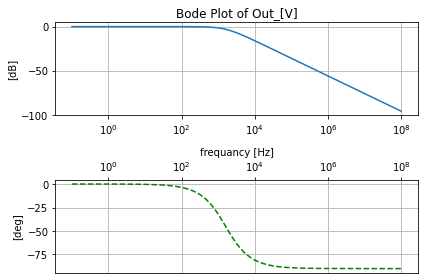
Here is the Nichols plot pf out data with parmteriztion arrows showing the direction of increasing frequancy. Note that since that data was aquared logrimgly and the space inside eecomplex_plot_templets.add_arrow uses linear supdivsion the spacing on the arrows is going to follow logrithmicly as well
ac_p.nichols_plot_templet(ac_rep_tool.ac_sim_mag_DF['Out_[V][dB]'], ac_rep_tool.ac_sim_phase_DF['Out_[V][deg]'],
title='Out_[V]')
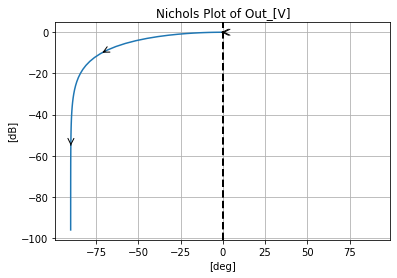
And finally, we create the Nyquist plot again with the same parametricness shown by the arrows and with the same linear to log issue in their spacing.
ac_p.nyquist_plot_templet(ac_rep_tool.ac_sim_real_DF['Out_[V]'], ac_rep_tool.ac_sim_imag_DF['Out_[V]'],
title='Out_[V]')
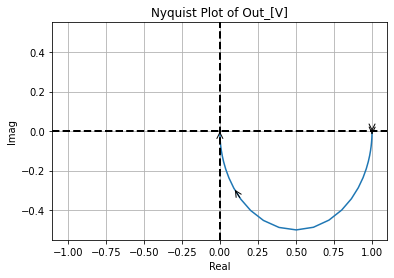
A quick filter exploration tool for the rest of this notebook¶¶
Here we create an easy use tool using mutable inheritance of our three ac tools wherein the __init__ method it performs the AC simulation, makes the representation transformations, and plot. And in the second method, we get grab the symbolic transfer function for the filter and pass it the same frequencies as the SPICE simulation and plot it on top of the SPICE simulation to examine any mild to gross divergence from the SPICE simulation and the symbolic.
#%%writefile -a AC_2_Codes.py
#chapteer 2 section 2 qfilter_explorer class
#class to perform the anylsis of the filtes in Ch2 sec 2
class qfilter_explorer(ac_ease, ac_representation_tool, eecomplex_plot_templets):
def __init__(self, circ, title, start_freq=.1@u_Hz, stop_freq=1@u_GHz):
#do what ac_ease is supposed to do at startup
#instainte the simulation from the circuit
ac_ease.__init__(self, circ)
#setup the simulation parameter with the helper method
self.ac_sweep_setup(start_freq, stop_freq, 20, 'decade', True)
#do the simulation
self.do_ac_sim()
#do what ac_representation_tool is supposed to do at startup
#and pass in the selfs from `ac_ease`'s ac_resultsNB_DF
ac_representation_tool.__init__(self, self.ac_resultsNB_DF)
#generate the representations
self.make_real_imag()
self.make_mag_phase()
eecomplex_plot_templets.__init__(self)
fig=plt.figure(constrained_layout=True, figsize=(8,8))
spec=fig.add_gridspec(2,2)
ax_bode=fig.add_subplot(spec[0, :])
self.bode_plot_one_templet(self.ac_sim_mag_DF.index, self.ac_sim_mag_DF['Out_[V][dB]'], self.ac_sim_phase_DF['Out_[V][deg]'],
title='Out_[V]', ax=ax_bode)
ax_nichols=fig.add_subplot(spec[1, 0])
self.nichols_plot_templet(self.ac_sim_mag_DF['Out_[V][dB]'], self.ac_sim_phase_DF['Out_[V][deg]'],
title='Out_[V]', ax=ax_nichols)
ax_nyquist=fig.add_subplot(spec[1, 1])
self.nyquist_plot_templet(self.ac_sim_real_DF['Out_[V]'], self.ac_sim_imag_DF['Out_[V]'],
title='Out_[V]', ax=ax_nyquist)
fig.suptitle(title)
def symbolic_tf(self, filter_obj):
self.symbolic_data=pd.DataFrame(index=self.ac_resultsNB_DF.index)
f=self.symbolic_data.index.values
#get the tf and get the data
tf=filter_obj.get_tf()
symbolic_data=tf.frequency_response(self.symbolic_data.index.values).astype('complex')
self.symbolic_data['Out_sym_[V][dB]']=20*np.log10(np.abs(symbolic_data))
self.symbolic_data['Out_sym_[V][deg]']=np.angle(symbolic_data, deg=True)
fig, [ax_mag, ax_ph]=plt.subplots(nrows=2, ncols=1)
self.bode_plot_two_templet(self.ac_sim_mag_DF.index, self.ac_sim_mag_DF['Out_[V][dB]'], self.ac_sim_phase_DF['Out_[V][deg]'],
title='Simulated vs Symbolic Out_[V]', axs=[ax_mag, ax_ph])
#add the symbolic data
ax_mag.semilogx(f, self.symbolic_data['Out_sym_[V][dB]'], linestyle='-.' , alpha=0.5, label='symbolic')
ax_mag.legend()
ax_ph.semilogx(f, self.symbolic_data['Out_sym_[V][deg]'], color='orange' , alpha=0.75, label='symbolic')
ax_ph.legend()
filter_responce=qfilter_explorer(circ, 'RC Low Pass Filter Responce');
| Start_freq | Stop_Freq | SamplingInc | StepType | |
|---|---|---|---|---|
| 0 | 0.1 Hz | 1 GHz | 20 | decade |

filter_responce.symbolic_tf(lowpassF)

##Equivalent Low Pass RL filter
Besides RC filters, there are of course RL dual filters. Where the equivalent RL filter values to any RC filter may be found via the equivalent time constant of the RC and RL implementation such that time constants must match ie: $\(RC=\tau_{RC}=\tau_{RL}=L/R\)$
#%%writefile -a AC_2_Codes.py
#chapteer 2 section 2 rl_lowpass filter class
#class with lcapy and skidl subcircuit to create an RL lowpass filter
class rl_lowpass():
"""
holding class for SkiDl subcircuit and lcapy schematic of a
lowpass RL filter primitive
"""
def __init__(self, subcirc_ref=None, L_value=1@u_H, R_value=1@u_Ohm):
"""
Args:
subcirc_ref (str): reference to use for the base of the internal elements
L_value (float; 1@u_H; Henery): the inductance in henrys for the RL inductive element
R_value (float; 1@u_Ohm; Ohms): the resistance in ohms for the RL resistive element
Returns:
None
TODO:
-add assertions
"""
#add assertions
self.subcirc_ref=subcirc_ref
self.L_value=L_value
self.R_value=R_value
@subcircuit
def SKiDl(self, term_0, term_1, term_2, term_3, return_elements=False):
"""
Terminals:
term_0, term_1, term_2, term_3
Terminals are defined via:
```
Left_Termanals - RL_Lowpass - Right_Termanals
+----+
Postive V_i term_0-|0 2|-term_2 Postive V_o
Negtive V_i term_1-|1 3|-term_3 Negtive V_o
+----+
```
Args:
return_internls (bool; False): If True return out the internal Voltage Source,
and Resistance objects in this package
Returns:
Returns elements to circuit RL lowpass filter part element object and if `return_internls`
is True will return the internal voltage and resistance objects in that order
"""
if self.subcirc_ref!=None:
Lref={'ref':f'L_{self.subcirc_ref}'}
Rref={'ref':f'R_{self.subcirc_ref}'}
else:
Lref={}
Rref={}
self.l=L(value=self.L_value, **Lref)
self.r=R(value=self.R_value, **Rref)
self.l['p', 'n']+=term_0, term_2
self.r[1, 2]+=self.l['n'], term_1
if return_elements:
return self.l, self.r
def lcapy_self(self, draw_me=True, with_values=True):
"""
Creates a lcapy schematic of this classes filter that
can be used for amongst other things: draw a basic schematic
of this class filter, extract the transfer function,
exstract the 2Port Repersntation
Args:
draw_me (bool): will draw a schematic of this classes filter schematic
with_values (bool): will push the filters element values into
the resulting lcapy circuit object in place of abstract sympy variables
Return:
the lcapys circuit object is stored in `self.schematic` and will
have abstract sympy variable for the elements if `with_values` is False
and will draw the schematic of just this classes filter if `draw_me` is True
TODO:
- get the Vin statement into the schematic
"""
self.schematic=kiwi.Circuit()
self.schematic.add('W 1 1_1; right=2')
self.schematic.add('W 0 0_1; right')
#self.schematic.add('P1 0 1; down, v=V_i')
self.schematic.add(f'L 0_1 2_1; right, l=L{str(self.L_value)}')
self.schematic.add(f'R 2_1 1_1; down, l=R{str(self.R_value)}')
self.schematic.add('W 2_1 2; right=1.5')
self.schematic.add('W 1_1 3; right=1.5')
self.schematic.add('P2 2 3; down, v=V_o')
if with_values:
self.schematic=self.schematic.subs({'R':self.R_value, 'L':self.L_value})
if draw_me:
self.schematic.draw()
def get_tf(self, with_values=True, ZPK=True):
"""
will extract the symbolic transfer function for this filter
Args:
with_values (bool): will push the filters element values into
the resulting lcapy circuit object in place of abstract sympy variables
ZPK (bool): if True will try to return the TF in zero-pole-gain form
else will try to return the TF in canonical form
where the unity coefficient is the highest power of the denominator
"""
self.lcapy_self(draw_me=False, with_values=with_values)
self.tf=self.schematic.transfer(0, 1, 2, 3)
if ZPK:
return self.tf.ZPK()
else:
return self.tf.canonical()
def get_twoPort(self, network_rep='Y', with_values=True):
"""
Gets the 2Port network representation of this filter.
The 2Port representation can be controlled
Args:
network_rep (str; 'Y'): control string for what
representation is used to choose from:
'Z': two-port Z-parameters matrix
'Y': two-port Y-parameters matrix
'H': two-port H-parameters matrix
'G': two-port G-parameters matrix
'ABCD': two-port A-parameters matrix
'invABCD': two-port B-parameters matrix
'S': two-port S-parameters matrix
'T': two-port T-parameters matrix
"""
self.lcapy_self(draw_me=False, with_values=with_values)
#create an action dict to get the 2P rep
rep_actions={
'Z':lambda x: x.Zparams(0, 1, 2, 1),
'Y':lambda x: x.Yparams(0, 1, 2, 1),
'H':lambda x: x.Hparams(0, 1, 2, 1),
'G':lambda x: x.Gparams(0, 1, 2, 1),
'ABCD':lambda x: x.Aparams(0, 1, 2, 1),
'invABCD':lambda x: x.Bparams(0, 1, 2, 1),
'S':lambda x: x.Sparams(0, 1, 2, 1),
'T':lambda x: x.Tparams(0, 1, 2, 1),
}
assert network_rep in rep_actions.keys(), f'`{network_rep}` is not 2Port rep'
return rep_actions[network_rep](self.schematic)
#instatate the rl_lowpass filter to
rl_l=rl_lowpass(L_value=(1e3)**2 *.1e-9 @u_H, R_value=1e3)
rl_l.lcapy_self()
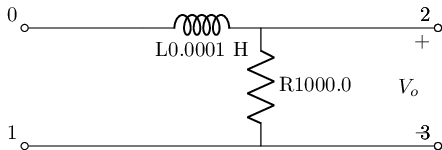
#get this filters abstract transfer function
rl_l.get_tf(with_values=False)
#get this filters transfer function
rl_l.get_tf(with_values=True)
reset()
#create the nets
net_in=Net('In'); net_out=Net('Out');
#create a 1V AC test source and attache to nets
vs=SINEV(ac_magnitude=1@u_V); vs['p', 'n']+=net_in, gnd
#attaceh term_0 to net_in and term_2 to net_out per scikit-rf convention all
#other terminals are grounded
rl_l.SKiDl(net_in, gnd, net_out, gnd)
circ=generate_netlist()
print(circ)
.title
V1 In 0 DC 0V AC 1V 0.0rad SIN(0V 1V 50Hz 0s 0Hz)
L1 In Out 0.0001H
R1 Out 0 1000.0
No errors or warnings found during netlist generation.
filter_responce=qfilter_explorer(circ, 'RL Low Pass Filter Responce');
| Start_freq | Stop_Freq | SamplingInc | StepType | |
|---|---|---|---|---|
| 0 | 0.1 Hz | 1 GHz | 20 | decade |

filter_responce.symbolic_tf(rl_l)
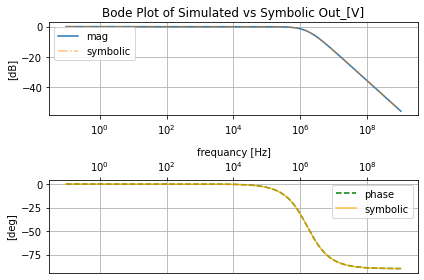
The high pass filter from ALL ABOUT ELECTRONICS “RC High Pass Filter Explained” @~ 7:57min¶
As we saw with the RC and RL “Lowpass” filters they are named by the typical convention of how there implemented followed by some characteristic description of their magnitude response. Thus, lowpass filters minimally attenuate any single whose frequency content is less than the frequency of their 3dB knee. Whereas Highpass filters are the complement to that where they will highly attenuate any single whose frequency content is less than there 3dB knee as shown below using the example from ALL ABOUT ELELECTROINC YT video on “RC High Pass Filters”
YouTubeVideo('9Dx0b0ukNAM', width=500, height=400, start=477)
#%%writefile -a AC_2_Codes.py
#chapteer 2 section 2 rc_highpass filter class
#class with lcapy and skidl subcircuit to create an RC highpass filter
class rc_highpass():
"""
holding class for SkiDl subcircuit and lcapy schematic of a
highpass RC filter primitive
"""
def __init__(self, subcirc_ref=None, C_value=1@u_F, R_value=1@u_Ohm):
"""
Args:
subcirc_ref (str): reference to use for the base of the internal elements
C_value (float; 1@u_F; Farads): the capacitance in farads for the RC capacitive element
R_value (float; 1@u_Ohm; Ohms): the resistance in ohms for the RC resistive element
Returns:
None
TODO:
-add assertions
"""
#add assertions
self.subcirc_ref=subcirc_ref
self.C_value=C_value
self.R_value=R_value
@subcircuit
def SKiDl(self, term_0, term_1, term_2, term_3, return_elements=False):
"""
Terminals:
term_0, term_1, term_2, term_3
Terminals are defined via:
```
Left_Termanals - RC_highpass - Right_Termanals
+----+
Postive V_i term_0-|0 2|-term_2 Postive V_o
Negtive V_i term_1-|1 3|-term_3 Negtive V_o
+----+
```
Args:
return_internls (bool; False): If True return out the internal Voltage Source,
and Resistance objects in this package
Returns:
Returns elements to circuit RC highpass filter part element object and if `return_internls`
is True will return the internal voltage and resistance objects in that order
"""
if self.subcirc_ref!=None:
Cref={'ref':f'C_{self.subcirc_ref}'}
Rref={'ref':f'R_{self.subcirc_ref}'}
else:
Cref={}
Rref={}
self.c=C(value=self.C_value, **Cref)
self.r=R(value=self.R_value, **Rref)
self.c['p', 'n']+=term_0, term_2
self.r[1, 2]+=self.c['n'], term_1
if return_elements:
return self.c, self.r
def lcapy_self(self, draw_me=True, with_values=True):
"""
Creates a lcapy schematic of this classes filter that
can be used for amongst other things: draw a basic schematic
of this class filter, extract the transfer function,
exstract the 2Port Repersntation
Args:
draw_me (bool): will draw a schematic of this classes filter schematic
with_values (bool): will push the filters element values into
the resulting lcapy circuit object in place of abstract sympy variables
Return:
the lcapys circuit object is stored in `self.schematic` and will
have abstract sympy variable for the elements if `with_values` is False
and will draw the schematic of just this classes filter if `draw_me` is True
TODO:
- get the Vin statement into the schematic
"""
self.schematic=kiwi.Circuit()
self.schematic.add('W 1 1_1; right=2')
self.schematic.add('W 0 0_1; right')
#self.schematic.add('P1 0 1; down, v=V_i')
self.schematic.add('C 0_1 2_1; right')
self.schematic.add('R 2_1 1_1; down')
self.schematic.add('W 2_1 2; right=1.5')
self.schematic.add('W 1_1 3; right=1.5')
self.schematic.add('P2 2 3; down, v=V_o')
if with_values:
self.schematic=self.schematic.subs({'R':self.R_value, 'C':self.C_value})
if draw_me:
self.schematic.draw()
def get_tf(self, with_values=True, ZPK=True):
"""
will extract the symbolic transfer function for this filter
Args:
with_values (bool): will push the filters element values into
the resulting lcapy circuit object in place of abstract sympy variables
ZPK (bool): if True will try to return the TF in zero-pole-gain form
else will try to return the TF in canonical form
where the unity coefficient is the highest power of the denominator
"""
self.lcapy_self(draw_me=False, with_values=with_values)
self.tf=self.schematic.transfer(0, 1, 2, 3)
if ZPK:
return self.tf.ZPK()
else:
return self.tf.canonical()
def get_twoPort(self, network_rep='Y', with_values=True):
"""
Gets the 2Port network representation of this filter.
The 2Port representation can be controlled
Args:
network_rep (str; 'Y'): control string for what
representation is used to choose from:
'Z': two-port Z-parameters matrix
'Y': two-port Y-parameters matrix
'H': two-port H-parameters matrix
'G': two-port G-parameters matrix
'ABCD': two-port A-parameters matrix
'invABCD': two-port B-parameters matrix
'S': two-port S-parameters matrix
'T': two-port T-parameters matrix
"""
self.lcapy_self(draw_me=False, with_values=with_values)
#create an action dict to get the 2P rep
rep_actions={
'Z':lambda x: x.Zparams(0, 1, 2, 1),
'Y':lambda x: x.Yparams(0, 1, 2, 1),
'H':lambda x: x.Hparams(0, 1, 2, 1),
'G':lambda x: x.Gparams(0, 1, 2, 1),
'ABCD':lambda x: x.Aparams(0, 1, 2, 1),
'invABCD':lambda x: x.Bparams(0, 1, 2, 1),
'S':lambda x: x.Sparams(0, 1, 2, 1),
'T':lambda x: x.Tparams(0, 1, 2, 1),
}
assert network_rep in rep_actions.keys(), f'`{network_rep}` is not 2Port rep'
return rep_actions[network_rep](self.schematic)
highpassF=rc_highpass(C_value=1.5@u_nF, R_value=10@u_kOhm)
highpassF.lcapy_self()

#get this filters abstract transfer function
highpassF.get_tf(with_values=False)
#get this filters transfer function
highpassF.get_tf(with_values=True)
reset()
#create the nets
net_in=Net('In'); net_out=Net('Out');
#create a 1V AC test source and attache to nets
vs=SINEV(ac_magnitude=1@u_V); vs['p', 'n']+=net_in, gnd
#attaceh term_0 to net_in and term_2 to net_out per scikit-rf convention all
#other terminals are grounded
highpassF.SKiDl(net_in, gnd, net_out, gnd)
circ=generate_netlist()
print(circ)
.title
V1 In 0 DC 0V AC 1V 0.0rad SIN(0V 1V 50Hz 0s 0Hz)
C1 In Out 1.5nF
R1 Out 0 10kOhm
No errors or warnings found during netlist generation.
filter_responce=qfilter_explorer(circ, 'RC High Pass Filter Responce');
| Start_freq | Stop_Freq | SamplingInc | StepType | |
|---|---|---|---|---|
| 0 | 0.1 Hz | 1 GHz | 20 | decade |
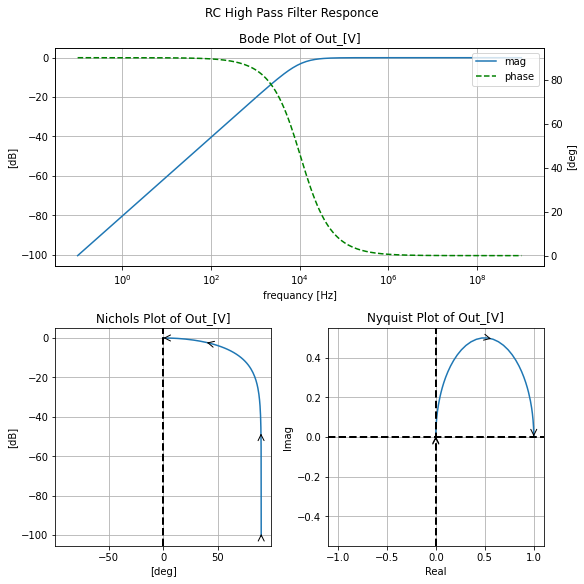
filter_responce.symbolic_tf(highpassF)
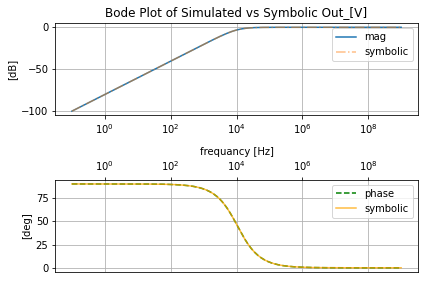
RL Highpass¶
#%%writefile -a AC_2_Codes.py
#chapteer 2 section 2 rl_highpass filter class
#class with lcapy and skidl subcircuit to create an RL highpass filter
class rl_highpass():
"""
holding class for SkiDl subcircuit and lcapy schematic of a
highpass RL filter primitive
"""
def __init__(self, subcirc_ref=None, L_value=1@u_H, R_value=1@u_Ohm):
"""
Args:
subcirc_ref (str): reference to use for the base of the internal elements
L_value (float; 1@u_F; Henerys): the inductance in farads for the RL inductive element
R_value (float; 1@u_Ohm; Ohms): the resistance in ohms for the RL resistive element
Returns:
None
TODO:
-add assertions
"""
#add assertions
self.subcirc_ref=subcirc_ref
self.L_value=L_value
self.R_value=R_value
@subcircuit
def SKiDl(self, term_0, term_1, term_2, term_3, return_elements=False):
"""
Terminals:
term_0, term_1, term_2, term_3
Terminals are defined via:
```
Left_Termanals - RL_highpass - Right_Termanals
+----+
Postive V_i term_0-|0 2|-term_2 Postive V_o
Negtive V_i term_1-|1 3|-term_3 Negtive V_o
+----+
```
Args:
return_internls (bool; False): If True return out the internal Voltage Source,
and Resistance objects in this package
Returns:
Returns elements to circuit RL highpass filter part element object and if `return_internls`
is True will return the internal voltage and resistance objects in that order
"""
if self.subcirc_ref!=None:
Lref={'ref':f'L_{self.subcirc_ref}'}
Rref={'ref':f'R_{self.subcirc_ref}'}
else:
Lref={}
Rref={}
self.l=L(value=self.L_value, **Lref)
self.r=R(value=self.R_value, **Rref)
self.r[1, 2]+=term_0, self.l['p']
self.l['p', 'n']+=term_2, term_3
if return_elements:
return self.l, self.r
def lcapy_self(self, draw_me=True, with_values=True):
"""
Creates a lcapy schematic of this classes filter that
can be used for amongst other things: draw a basic schematic
of this class filter, extract the transfer function,
exstract the 2Port Repersntation
Args:
draw_me (bool): will draw a schematic of this classes filter schematic
with_values (bool): will push the filters element values into
the resulting lcapy circuit object in place of abstract sympy variables
Return:
the lcapys circuit object is stored in `self.schematic` and will
have abstract sympy variable for the elements if `with_values` is False
and will draw the schematic of just this classes filter if `draw_me` is True
TODO:
- get the Vin statement into the schematic
"""
self.schematic=kiwi.Circuit()
self.schematic.add('W 1 1_1; right=2')
self.schematic.add('W 0 0_1; right')
#self.schematic.add('P1 0 1; down, v=V_i')
self.schematic.add(f'R 0_1 2_1; right')
self.schematic.add(f'L 2_1 1_1; down')
self.schematic.add('W 2_1 2; right=1.5')
self.schematic.add('W 1_1 3; right=1.5')
self.schematic.add('P2 2 3; down, v=V_o')
if with_values:
self.schematic=self.schematic.subs({'R':self.R_value, 'L':self.L_value})
if draw_me:
self.schematic.draw()
def get_tf(self, with_values=True, ZPK=True):
"""
will extract the symbolic transfer function for this filter
Args:
with_values (bool): will push the filters element values into
the resulting lcapy circuit object in place of abstract sympy variables
ZPK (bool): if True will try to return the TF in zero-pole-gain form
else will try to return the TF in canonical form
where the unity coefficient is the highest power of the denominator
"""
self.lcapy_self(draw_me=False, with_values=with_values)
self.tf=self.schematic.transfer(0, 1, 2, 3)
if ZPK:
return self.tf.ZPK()
else:
return self.tf.canonical()
def get_twoPort(self, network_rep='Y', with_values=True):
"""
Gets the 2Port network representation of this filter.
The 2Port representation can be controlled
Args:
network_rep (str; 'Y'): control string for what
representation is used to choose from:
'Z': two-port Z-parameters matrix
'Y': two-port Y-parameters matrix
'H': two-port H-parameters matrix
'G': two-port G-parameters matrix
'ABCD': two-port A-parameters matrix
'invABCD': two-port B-parameters matrix
'S': two-port S-parameters matrix
'T': two-port T-parameters matrix
"""
self.lcapy_self(draw_me=False, with_values=with_values)
#create an action dict to get the 2P rep
rep_actions={
'Z':lambda x: x.Zparams(0, 1, 2, 1),
'Y':lambda x: x.Yparams(0, 1, 2, 1),
'H':lambda x: x.Hparams(0, 1, 2, 1),
'G':lambda x: x.Gparams(0, 1, 2, 1),
'ABCD':lambda x: x.Aparams(0, 1, 2, 1),
'invABCD':lambda x: x.Bparams(0, 1, 2, 1),
'S':lambda x: x.Sparams(0, 1, 2, 1),
'T':lambda x: x.Tparams(0, 1, 2, 1),
}
assert network_rep in rep_actions.keys(), f'`{network_rep}` is not 2Port rep'
return rep_actions[network_rep](self.schematic)
rl_h=rl_highpass(L_value=(10e3)**2 *1.5e-9 @u_H, R_value=10@u_kOhm)
rl_h.lcapy_self()
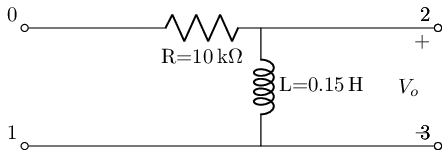
#get this filters abstract transfer function
rl_h.get_tf(with_values=False)
#get this filters transfer function
rl_h.get_tf(with_values=True)
reset()
#create the nets
net_in=Net('In'); net_out=Net('Out');
#create a 1V AC test source and attache to nets
vs=SINEV(ac_magnitude=1@u_V); vs['p', 'n']+=net_in, gnd
#attaceh term_0 to net_in and term_2 to net_out per scikit-rf convention all
#other terminals are grounded
rl_h.SKiDl(net_in, gnd, net_out, gnd)
circ=generate_netlist()
print(circ)
.title
V1 In 0 DC 0V AC 1V 0.0rad SIN(0V 1V 50Hz 0s 0Hz)
L1 Out 0 0.15H
R1 In Out 10kOhm
No errors or warnings found during netlist generation.
filter_responce=qfilter_explorer(circ, 'RL High Pass Filter Responce');
| Start_freq | Stop_Freq | SamplingInc | StepType | |
|---|---|---|---|---|
| 0 | 0.1 Hz | 1 GHz | 20 | decade |
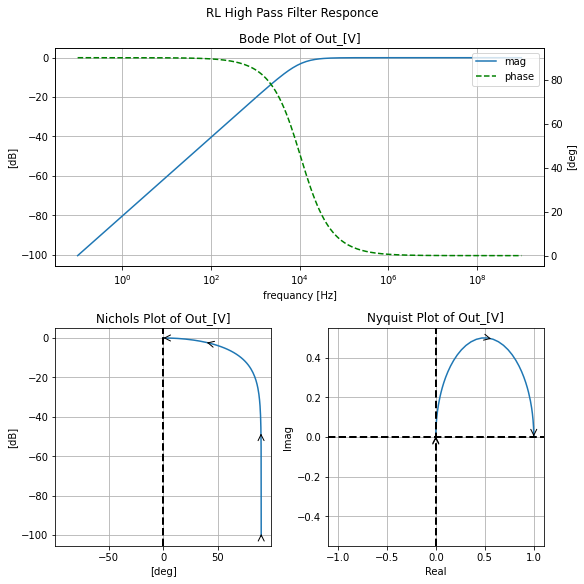
filter_responce.symbolic_tf(rl_h)
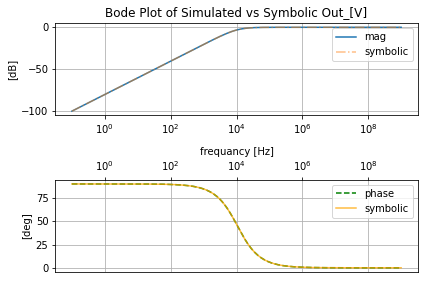
First Order Cascade filter¶
Though as we will see there are more complex single filter designs that can implement a needed filter profile the other way to implement the needed filter profile is by cascading primitive filter sections as shown by ALL ABOUT ELELECTOINCS where here we will just implement the passive version of the cascaded bandpass filter shown below.
The band pass filter from ALL ABOUT ELECTRONICS “Band Pass Filter and Band Stop Filter Explained” @~ 4:03min¶
YouTubeVideo('dmPIydL0lyM', width=500, height=400, start=243)
reset()
net_in=Net('In'); net_inter=Net('Inter'); net_out=Net('Out')
vs=SINEV(amplitude=10@u_V, frequency=10@u_kHz)
vs['p', 'n']+=net_in, gnd
highpassFsection=rc_highpass(C_value=1.5@u_nF, R_value=10@u_kOhm)
highpassFsection.SKiDl(net_in, gnd, net_inter, gnd)
lowpassFsection=rc_lowpass(C_value=1.5@u_nF, R_value=1@u_kOhm)
lowpassFsection.SKiDl(net_inter, gnd, net_out, gnd)
circ=generate_netlist()
print(circ)
.title
V1 In 0 DC 0V AC 1V 0.0rad SIN(0V 10V 10kHz 0s 0Hz)
C1 In Inter 1.5nF
R1 Inter 0 10kOhm
C2 Out 0 1.5nF
R2 Inter Out 1kOhm
No errors or warnings found during netlist generation.
filter_responce=qfilter_explorer(circ, 'RC Band pass Filter Responce');
| Start_freq | Stop_Freq | SamplingInc | StepType | |
|---|---|---|---|---|
| 0 | 0.1 Hz | 1 GHz | 20 | decade |
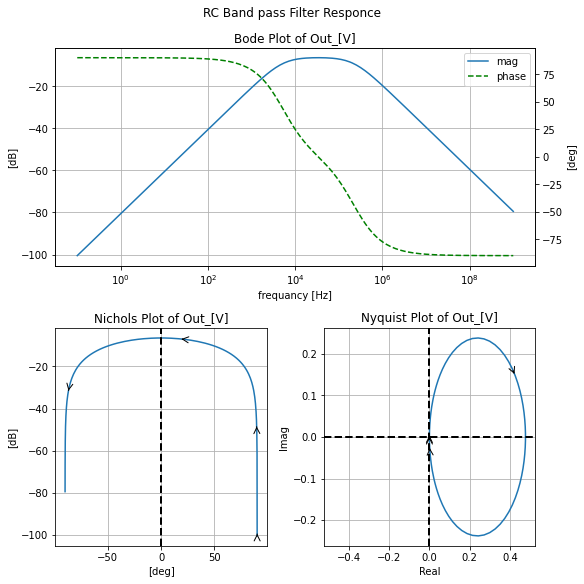
Becouse this is a cascaded filter to get the symbolic filter we need to casade them where for a recap of how to cascade filters in all the varies toplogies see https://x-engineer.org/graduate-engineering/signals-systems/control-systems/transfer-function-algebra/
cascade_tf=highpassFsection.get_tf() * lowpassFsection.get_tf()
sym.sympify(cascade_tf)
And so for the sake of simplicity we will just reimpliment qfilter_explorer.symbolic_tf manulay here to compare the casdacded symbolic trnasfer fuction to the SPICE simulated results
symbolic_data=pd.DataFrame(index=filter_responce.ac_resultsNB_DF.index)
f=symbolic_data.index.values
##bring the f through the sausage filter
symbolic_data_raw=cascade_tf.frequency_response(f).astype('complex')
symbolic_data['Out_sym_[V][dB]']=20*np.log10(np.abs(symbolic_data_raw))
symbolic_data['Out_sym_[V][deg]']=np.angle(symbolic_data_raw, deg=True)
fig, [ax_mag, ax_ph]=plt.subplots(nrows=2, ncols=1)
acplot=eecomplex_plot_templets()
acplot.bode_plot_two_templet(filter_responce.ac_sim_mag_DF.index, filter_responce.ac_sim_mag_DF['Out_[V][dB]'], filter_responce.ac_sim_phase_DF['Out_[V][deg]'],
title='Simulated vs Symbolic Out_[V]', axs=[ax_mag, ax_ph])
#add the symbolic data
ax_mag.semilogx(f, symbolic_data['Out_sym_[V][dB]'], linestyle='-.' , alpha=0.5, label='symbolic')
ax_mag.legend()
ax_ph.semilogx(f, symbolic_data['Out_sym_[V][deg]'], color='orange' , alpha=0.75, label='symbolic')
ax_ph.legend();
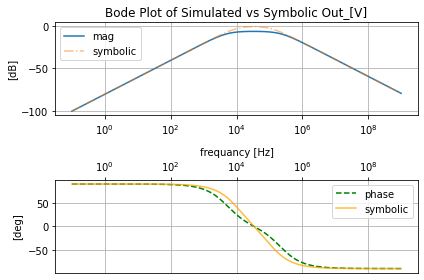
Second-Order Filters and resonators¶
Second-order filters are mostly designed around the following equations in their circuit implementation
Bandwidth (\(B\)):\(B=\omega_2-\omega_1\)
Center Frequncy (\(\omega_0\)): \(\omega_0=\dfrac{1}{\sqrt{LC}}=\sqrt{\omega_1 \omega_2}\)
The Q Factor in general: \(Q=\dfrac{\omega_0}{B}\)
Q for a series RLC is: \(Q=\dfrac{1}{\omega_0 RC}\)
Q for a parrel RLC is: \(Q=\omega_0 RC\)
And are called second-order since with having both a Capacitor and Inductor the differential equations in the time domain become second order. Below we will implement the four main second-order filter types: Lowpass, Highpass, Bandpass, Bandstop, in both their series and parral configurations. Where the templet around the values for the RLC elements used for these filters is the bandwidth frequencies of the ALL ABOUT CIRCUITS example of a passive cascaded filter above using a 50Ohm resistor, because.
Series Based¶¶
V_out, V_in, angfreq_1, angfreq_2, angfreq_0, R_sym, C_sym, L_sym, Q_sym, f_sym, f0_sym, B_sym=sym.symbols('V_{out}, V_{in}, omega_1, omega_2, omega_0, R, C, L, Q, f, f_0, B' )
V_out, V_in, angfreq_1, angfreq_2, angfreq_0, R_sym, C_sym, L_sym, Q_sym, f_sym, f0_sym, B_sym

f1=10.61e3; f2=106.1e3
subs={R_sym:50}
subs[angfreq_1]=2*np.pi*f1; subs[angfreq_2]=2*np.pi*f2
subs[angfreq_0]=np.sqrt(subs[angfreq_1]*subs[angfreq_2])
subs[B_sym]=subs[angfreq_2]-subs[angfreq_1]
subs[Q_sym]=subs[angfreq_0]/subs[B_sym]
subs

Qs_eq=sym.Eq(Q_sym, 1/(angfreq_0*R_sym*C_sym)); Qs_eq

subs[C_sym]=sym.solve(Qs_eq, C_sym)[0].subs(subs); subs

angfreq_0_eq=sym.Eq(angfreq_0, 1/sym.sqrt(L_sym*C_sym)); angfreq_0_eq

subs[L_sym]=sym.solve(angfreq_0_eq, L_sym)[0].subs(subs); subs

RLC series lowpass¶
#%%writefile -a AC_2_Codes.py
#chapteer 2 section 2 rlc_series_lowpass filter class
#class with lcapy and skidl subcircuit to create an RLC series lowpass filter
class rlc_series_lowpass():
"""
holding class for SkiDl subcircuit and lcapy schematic of a
lowpass series RLC filter primitive
"""
def __init__(self, subcirc_ref=None, L_value=1@u_H, C_value=1@u_F, R_value=1@u_Ohm):
"""
Args:
subcirc_ref (str): reference to use for the base of the internal elements
L_value (float; 1@u_F; Henerys): the inductance in farads for the RLC inductive element
C_value (float; 1@u_F; Farads): the capacitance in farads for the RLC capacitive element
R_value (float; 1@u_Ohm; Ohms): the resistance in ohms for the RLC resistive element
Returns:
None
TODO:
-add assertions
"""
#add assertions
self.subcirc_ref=subcirc_ref
self.L_value=L_value
self.C_value=C_value
self.R_value=R_value
@subcircuit
def SKiDl(self, term_0, term_1, term_2, term_3, return_elements=False):
"""
Terminals:
term_0, term_1, term_2, term_3
Terminals are defined via:
```
Left_Termanals - RLC_s_Lowpass - Right_Termanals
+----+
Postive V_i term_0-|0 2|-term_2 Postive V_o
Negtive V_i term_1-|1 3|-term_3 Negtive V_o
+----+
```
Args:
return_internls (bool; False): If True return out the internal Voltage Source,
and Resistance objects in this package
Returns:
Returns elements to circuit RLC series lowpass filter part element object and if `return_internls`
is True will return the internal voltage and resistance objects in that order
"""
if self.subcirc_ref!=None:
Lref={'ref':f'L_{self.subcirc_ref}'}
Cref={'ref':f'C_{self.subcirc_ref}'}
Rref={'ref':f'R_{self.subcirc_ref}'}
else:
Lref={}
Cref={}
Rref={}
self.l=L(value=self.L_value, **Lref)
self.c=C(value=self.C_value, **Cref)
self.r=R(value=self.R_value, **Rref)
self.r[1, 2]+=term_0, self.l[1]
self.l[2]+=term_2, self.c['p']
self.c['n']+=term_1, term_3
if return_elements:
return self.c, self.r, self.l
def lcapy_self(self, draw_me=True, with_values=True):
"""
Creates a lcapy schematic of this classes filter that
can be used for amongst other things: draw a basic schematic
of this class filter, extract the transfer function,
exstract the 2Port Repersntation
Args:
draw_me (bool): will draw a schematic of this classes filter schematic
with_values (bool): will push the filters element values into
the resulting lcapy circuit object in place of abstract sympy variables
Return:
the lcapys circuit object is stored in `self.schematic` and will
have abstract sympy variable for the elements if `with_values` is False
and will draw the schematic of just this classes filter if `draw_me` is True
TODO:
- get the Vin statement into the schematic
"""
self.schematic=kiwi.Circuit()
self.schematic.add('W 0 0_1; right')
self.schematic.add('W 1 1_1; right=3')
#self.schematic.add('P1 0 1; down, v=V_i')
self.schematic.add('R 0_1 N1; right')
self.schematic.add('L N1 2_1; right')
self.schematic.add('C 2_1 1_1; down')
self.schematic.add('W 2_1 2; right=1.5')
self.schematic.add('W 1_1 3; right=1.5')
self.schematic.add('P2 2 3; down, v=V_o')
if with_values:
self.schematic=self.schematic.subs({'R':self.R_value, 'L':self.L_value, 'C':self.C_value})
if draw_me:
self.schematic.draw()
def get_tf(self, with_values=True, ZPK=True):
"""
will extract the symbolic transfer function for this filter
Args:
with_values (bool): will push the filters element values into
the resulting lcapy circuit object in place of abstract sympy variables
ZPK (bool): if True will try to return the TF in zero-pole-gain form
else will try to return the TF in canonical form
where the unity coefficient is the highest power of the denominator
"""
self.lcapy_self(draw_me=False, with_values=with_values)
self.tf=self.schematic.transfer(0, 1, 2, 3)
if ZPK:
return self.tf.ZPK()
else:
return self.tf.canonical()
def get_twoPort(self, network_rep='Y', with_values=True):
"""
Gets the 2Port network representation of this filter.
The 2Port representation can be controlled
Args:
network_rep (str; 'Y'): control string for what
representation is used to choose from:
'Z': two-port Z-parameters matrix
'Y': two-port Y-parameters matrix
'H': two-port H-parameters matrix
'G': two-port G-parameters matrix
'ABCD': two-port A-parameters matrix
'invABCD': two-port B-parameters matrix
'S': two-port S-parameters matrix
'T': two-port T-parameters matrix
"""
self.lcapy_self(draw_me=False, with_values=with_values)
#create an action dict to get the 2P rep
rep_actions={
'Z':lambda x: x.Zparams(0, 1, 2, 1),
'Y':lambda x: x.Yparams(0, 1, 2, 1),
'H':lambda x: x.Hparams(0, 1, 2, 1),
'G':lambda x: x.Gparams(0, 1, 2, 1),
'ABCD':lambda x: x.Aparams(0, 1, 2, 1),
'invABCD':lambda x: x.Bparams(0, 1, 2, 1),
'S':lambda x: x.Sparams(0, 1, 2, 1),
'T':lambda x: x.Tparams(0, 1, 2, 1),
}
assert network_rep in rep_actions.keys(), f'`{network_rep}` is not 2Port rep'
return rep_actions[network_rep](self.schematic)
#instatate the rlc_lowpass filter
lowpassRLC_s=rlc_series_lowpass(L_value=8.33e-5@u_H, C_value=2.7e-7@u_F, R_value=50@u_Ohm)
lowpassRLC_s.lcapy_self()

#get this filters abstract transfer function
lowpassRLC_s.get_tf(with_values=False)
#get this filters transfer function
lowpassRLC_s.get_tf(with_values=True)
reset()
#create the nets
net_in=Net('In'); net_out=Net('Out');
#create a 1V AC test source and attache to nets
vs=SINEV(ac_magnitude=1@u_V); vs['p', 'n']+=net_in, gnd
#attaceh term_0 to net_in and term_2 to net_out per scikit-rf convention all
#other terminals are grounded
lowpassRLC_s.SKiDl(net_in, gnd, net_out, gnd)
circ=generate_netlist()
print(circ)
.title
V1 In 0 DC 0V AC 1V 0.0rad SIN(0V 1V 50Hz 0s 0Hz)
L1 N_1 Out 8.33e-05H
C1 Out 0 2.7e-07
R1 In N_1 50Ohm
No errors or warnings found during netlist generation.
filter_responce=qfilter_explorer(circ, 'RLC Series Lowpass Filter Responce');
| Start_freq | Stop_Freq | SamplingInc | StepType | |
|---|---|---|---|---|
| 0 | 0.1 Hz | 1 GHz | 20 | decade |
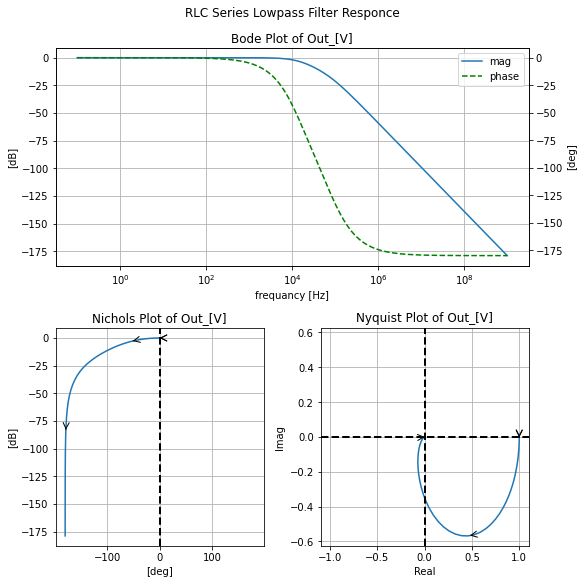
filter_responce.symbolic_tf(lowpassRLC_s)
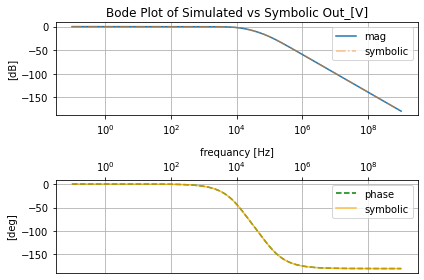
RLC series highpass¶
#%%writefile -a AC_2_Codes.py
#chapteer 2 section 2 rlc_series_highpass filter class
#class with lcapy and skidl subcircuit to create an RLC series highpass filter
class rlc_series_highpass():
"""
holding class for SkiDl subcircuit and lcapy schematic of a
highpass series RLC filter primitive
"""
def __init__(self, subcirc_ref=None, L_value=1@u_H, C_value=1@u_F, R_value=1@u_Ohm):
"""
Args:
subcirc_ref (str): reference to use for the base of the internal elements
L_value (float; 1@u_F; Henerys): the inductance in farads for the RLC inductive element
C_value (float; 1@u_F; Farads): the capacitance in farads for the RLC capacitive element
R_value (float; 1@u_Ohm; Ohms): the resistance in ohms for the RLC resistive element
Returns:
None
TODO:
-add assertions
"""
#add assertions
self.subcirc_ref=subcirc_ref
self.L_value=L_value
self.C_value=C_value
self.R_value=R_value
@subcircuit
def SKiDl(self, term_0, term_1, term_2, term_3, return_elements=False):
"""
Terminals:
term_0, term_1, term_2, term_3
Terminals are defined via:
```
Left_Termanals - RLC_s_highpass - Right_Termanals
+----+
Postive V_i term_0-|0 2|-term_2 Postive V_o
Negtive V_i term_1-|1 3|-term_3 Negtive V_o
+----+
```
Args:
return_internls (bool; False): If True return out the internal Voltage Source,
and Resistance objects in this package
Returns:
Returns elements to circuit RLC series highpass filter part element object and if `return_internls`
is True will return the internal voltage and resistance objects in that order
"""
if self.subcirc_ref!=None:
Lref={'ref':f'L_{self.subcirc_ref}'}
Cref={'ref':f'C_{self.subcirc_ref}'}
Rref={'ref':f'R_{self.subcirc_ref}'}
else:
Lref={}
Cref={}
Rref={}
self.l=L(value=self.L_value, **Lref)
self.c=C(value=self.C_value, **Cref)
self.r=R(value=self.R_value, **Rref)
self.r[1, 2]+=term_0, self.c['p']
self.c['n']+=term_2, self.l[1]
self.l[2]+=term_1, term_3
if return_elements:
return self.c, self.r, self.l
def lcapy_self(self, draw_me=True, with_values=True):
"""
Creates a lcapy schematic of this classes filter that
can be used for amongst other things: draw a basic schematic
of this class filter, extract the transfer function,
exstract the 2Port Repersntation
Args:
draw_me (bool): will draw a schematic of this classes filter schematic
with_values (bool): will push the filters element values into
the resulting lcapy circuit object in place of abstract sympy variables
Return:
the lcapys circuit object is stored in `self.schematic` and will
have abstract sympy variable for the elements if `with_values` is False
and will draw the schematic of just this classes filter if `draw_me` is True
TODO:
- get the Vin statement into the schematic
"""
self.schematic=kiwi.Circuit()
self.schematic.add('W 0 0_1; right')
self.schematic.add('W 1 1_1; right=3')
#self.schematic.add('P1 0 1; down, v=V_i')
self.schematic.add(f'R 0_1 N1; right')
self.schematic.add(f'C N1 2_1; right')
self.schematic.add(f'L 2_1 1_1; down')
self.schematic.add('W 2_1 2; right=1.5')
self.schematic.add('W 1_1 3; right=1.5')
self.schematic.add('P2 2 3; down, v=V_o')
if with_values:
self.schematic=self.schematic.subs({'R':self.R_value, 'L':self.L_value, 'C':self.C_value})
if draw_me:
self.schematic.draw()
def get_tf(self, with_values=True, ZPK=True):
"""
will extract the symbolic transfer function for this filter
Args:
with_values (bool): will push the filters element values into
the resulting lcapy circuit object in place of abstract sympy variables
ZPK (bool): if True will try to return the TF in zero-pole-gain form
else will try to return the TF in canonical form
where the unity coefficient is the highest power of the denominator
"""
self.lcapy_self(draw_me=False, with_values=with_values)
self.tf=self.schematic.transfer(0, 1, 2, 3)
if ZPK:
return self.tf.ZPK()
else:
return self.tf.canonical()
def get_twoPort(self, network_rep='Y', with_values=True):
"""
Gets the 2Port network representation of this filter.
The 2Port representation can be controlled
Args:
network_rep (str; 'Y'): control string for what
representation is used to choose from:
'Z': two-port Z-parameters matrix
'Y': two-port Y-parameters matrix
'H': two-port H-parameters matrix
'G': two-port G-parameters matrix
'ABCD': two-port A-parameters matrix
'invABCD': two-port B-parameters matrix
'S': two-port S-parameters matrix
'T': two-port T-parameters matrix
"""
self.lcapy_self(draw_me=False, with_values=with_values)
#create an action dict to get the 2P rep
rep_actions={
'Z':lambda x: x.Zparams(0, 1, 2, 1),
'Y':lambda x: x.Yparams(0, 1, 2, 1),
'H':lambda x: x.Hparams(0, 1, 2, 1),
'G':lambda x: x.Gparams(0, 1, 2, 1),
'ABCD':lambda x: x.Aparams(0, 1, 2, 1),
'invABCD':lambda x: x.Bparams(0, 1, 2, 1),
'S':lambda x: x.Sparams(0, 1, 2, 1),
'T':lambda x: x.Tparams(0, 1, 2, 1),
}
assert network_rep in rep_actions.keys(), f'`{network_rep}` is not 2Port rep'
return rep_actions[network_rep](self.schematic)
#instatate the rlc_highpass filter
highpassRLC_s=rlc_series_highpass(L_value=8.33e-5@u_H, C_value=2.7e-7@u_F, R_value=50@u_Ohm)
highpassRLC_s.lcapy_self()

#get this filters abstract transfer function
highpassRLC_s.get_tf(with_values=False)
#get this filters transfer function
highpassRLC_s.get_tf(with_values=True)
reset()
#create the nets
net_in=Net('In'); net_out=Net('Out');
#create a 1V AC test source and attache to nets
vs=SINEV(ac_magnitude=1@u_V); vs['p', 'n']+=net_in, gnd
#attaceh term_0 to net_in and term_2 to net_out per scikit-rf convention all
#other terminals are grounded
highpassRLC_s.SKiDl(net_in, gnd, net_out, gnd)
circ=generate_netlist()
print(circ)
.title
V1 In 0 DC 0V AC 1V 0.0rad SIN(0V 1V 50Hz 0s 0Hz)
L1 Out 0 8.33e-05H
C1 N_1 Out 2.7e-07
R1 In N_1 50Ohm
No errors or warnings found during netlist generation.
filter_responce=qfilter_explorer(circ, 'RLC Series Lowpass Filter Responce');
| Start_freq | Stop_Freq | SamplingInc | StepType | |
|---|---|---|---|---|
| 0 | 0.1 Hz | 1 GHz | 20 | decade |
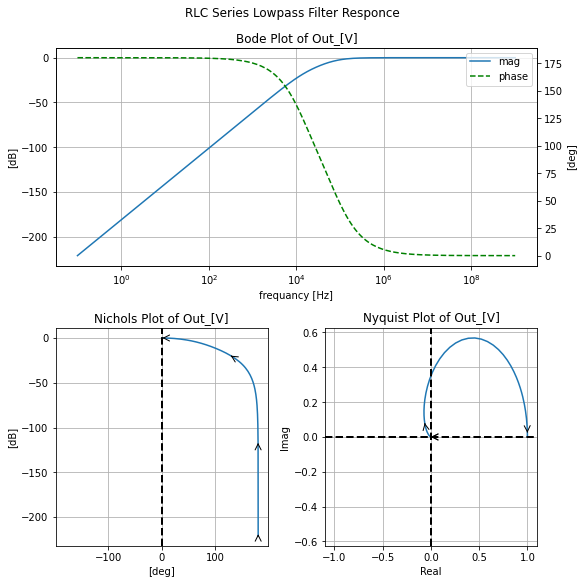
filter_responce.symbolic_tf(highpassRLC_s)
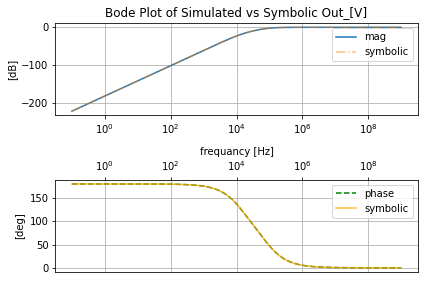
RLC series bandpass¶
#%%writefile -a AC_2_Codes.py
#chapteer 2 section 2 rlc_series_bandpass filter class
#class with lcapy and skidl subcircuit to create an RLC series bandpass filter
class rlc_series_bandpass():
"""
holding class for SkiDl subcircuit and lcapy schematic of a
bandpass series RLC filter primitive
"""
def __init__(self, subcirc_ref=None, L_value=1@u_H, C_value=1@u_F, R_value=1@u_Ohm):
"""
Args:
subcirc_ref (str): reference to use for the base of the internal elements
L_value (float; 1@u_F; Henerys): the inductance in farads for the RLC inductive element
C_value (float; 1@u_F; Farads): the capacitance in farads for the RLC capacitive element
R_value (float; 1@u_Ohm; Ohms): the resistance in ohms for the RLC resistive element
Returns:
None
TODO:
-add assertions
"""
#add assertions
self.subcirc_ref=subcirc_ref
self.L_value=L_value
self.C_value=C_value
self.R_value=R_value
@subcircuit
def SKiDl(self, term_0, term_1, term_2, term_3, return_elements=False):
"""
Terminals:
term_0, term_1, term_2, term_3
Terminals are defined via:
```
Left_Termanals - RLC_s_bandpass - Right_Termanals
+----+
Postive V_i term_0-|0 2|-term_2 Postive V_o
Negtive V_i term_1-|1 3|-term_3 Negtive V_o
+----+
```
Args:
return_internls (bool; False): If True return out the internal Voltage Source,
and Resistance objects in this package
Returns:
Returns elements to circuit RLC series bandpass filter part element object and if `return_internls`
is True will return the internal voltage and resistance objects in that order
"""
if self.subcirc_ref!=None:
Lref={'ref':f'L_{self.subcirc_ref}'}
Cref={'ref':f'C_{self.subcirc_ref}'}
Rref={'ref':f'R_{self.subcirc_ref}'}
else:
Lref={}
Cref={}
Rref={}
self.l=L(value=self.L_value, **Lref)
self.c=C(value=self.C_value, **Cref)
self.r=R(value=self.R_value, **Rref)
self.l[1, 2]+=term_0, self.c['p']
self.c['n']+=term_2, self.r[1]
self.r[2]+=term_1, term_3
if return_elements:
return self.c, self.r, self.l
def lcapy_self(self, draw_me=True, with_values=True):
"""
Creates a lcapy schematic of this classes filter that
can be used for amongst other things: draw a basic schematic
of this class filter, extract the transfer function,
exstract the 2Port Repersntation
Args:
draw_me (bool): will draw a schematic of this classes filter schematic
with_values (bool): will push the filters element values into
the resulting lcapy circuit object in place of abstract sympy variables
Return:
the lcapys circuit object is stored in `self.schematic` and will
have abstract sympy variable for the elements if `with_values` is False
and will draw the schematic of just this classes filter if `draw_me` is True
TODO:
- get the Vin statement into the schematic
"""
self.schematic=kiwi.Circuit()
self.schematic.add('W 0 0_1; right')
self.schematic.add('W 1 1_1; right=3')
#self.schematic.add('P1 0 1; down, v=V_i')
self.schematic.add(f'L 0_1 N1; right')
self.schematic.add(f'C N1 2_1; right')
self.schematic.add(f'R 2_1 1_1; down')
self.schematic.add('W 2_1 2; right=1.5')
self.schematic.add('W 1_1 3; right=1.5')
self.schematic.add('P2 2 3; down, v=V_o')
if with_values:
self.schematic=self.schematic.subs({'R':self.R_value, 'L':self.L_value, 'C':self.C_value})
if draw_me:
self.schematic.draw()
def get_tf(self, with_values=True, ZPK=True):
"""
will extract the symbolic transfer function for this filter
Args:
with_values (bool): will push the filters element values into
the resulting lcapy circuit object in place of abstract sympy variables
ZPK (bool): if True will try to return the TF in zero-pole-gain form
else will try to return the TF in canonical form
where the unity coefficient is the highest power of the denominator
"""
self.lcapy_self(draw_me=False, with_values=with_values)
self.tf=self.schematic.transfer(0, 1, 2, 3)
if ZPK:
return self.tf.ZPK()
else:
return self.tf.canonical()
def get_twoPort(self, network_rep='Y', with_values=True):
"""
Gets the 2Port network representation of this filter.
The 2Port representation can be controlled
Args:
network_rep (str; 'Y'): control string for what
representation is used to choose from:
'Z': two-port Z-parameters matrix
'Y': two-port Y-parameters matrix
'H': two-port H-parameters matrix
'G': two-port G-parameters matrix
'ABCD': two-port A-parameters matrix
'invABCD': two-port B-parameters matrix
'S': two-port S-parameters matrix
'T': two-port T-parameters matrix
"""
self.lcapy_self(draw_me=False, with_values=with_values)
#create an action dict to get the 2P rep
rep_actions={
'Z':lambda x: x.Zparams(0, 1, 2, 1),
'Y':lambda x: x.Yparams(0, 1, 2, 1),
'H':lambda x: x.Hparams(0, 1, 2, 1),
'G':lambda x: x.Gparams(0, 1, 2, 1),
'ABCD':lambda x: x.Aparams(0, 1, 2, 1),
'invABCD':lambda x: x.Bparams(0, 1, 2, 1),
'S':lambda x: x.Sparams(0, 1, 2, 1),
'T':lambda x: x.Tparams(0, 1, 2, 1),
}
assert network_rep in rep_actions.keys(), f'`{network_rep}` is not 2Port rep'
return rep_actions[network_rep](self.schematic)
#instatate the rlc_bandpass filter
bandpassRLC_s=rlc_series_bandpass(L_value=8.33e-5@u_H, C_value=2.7e-7@u_F, R_value=50@u_Ohm)
bandpassRLC_s.lcapy_self()

#get this filters abstract transfer function
bandpassRLC_s.get_tf(with_values=False)
#get this filters transfer function
bandpassRLC_s.get_tf(with_values=True)
reset()
#create the nets
net_in=Net('In'); net_out=Net('Out');
#create a 1V AC test source and attache to nets
vs=SINEV(ac_magnitude=1@u_V); vs['p', 'n']+=net_in, gnd
#attaceh term_0 to net_in and term_2 to net_out per scikit-rf convention all
#other terminals are grounded
bandpassRLC_s.SKiDl(net_in, gnd, net_out, gnd)
circ=generate_netlist()
print(circ)
.title
V1 In 0 DC 0V AC 1V 0.0rad SIN(0V 1V 50Hz 0s 0Hz)
L1 In N_1 8.33e-05H
C1 N_1 Out 2.7e-07
R1 Out 0 50Ohm
No errors or warnings found during netlist generation.
filter_responce=qfilter_explorer(circ, 'RLC Series Bandpass Filter Responce');
| Start_freq | Stop_Freq | SamplingInc | StepType | |
|---|---|---|---|---|
| 0 | 0.1 Hz | 1 GHz | 20 | decade |
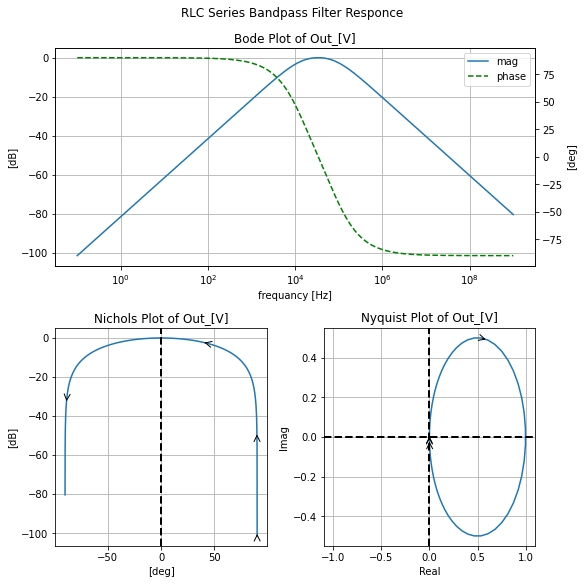
filter_responce.symbolic_tf(bandpassRLC_s)
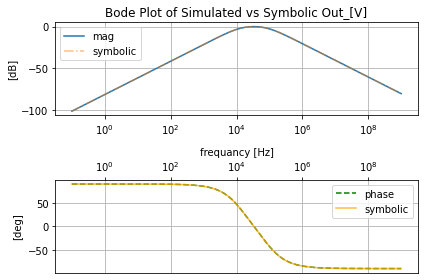
RLC series bandstop¶
#%%writefile -a AC_2_Codes.py
#chapteer 2 section 2 rlc_series_bandstop filter class
#class with lcapy and skidl subcircuit to create an RLC series bandstop filter
class rlc_series_bandstop():
"""
holding class for SkiDl subcircuit and lcapy schematic of a
bandstop series RLC filter primitive
"""
def __init__(self, subcirc_ref=None, L_value=1@u_H, C_value=1@u_F, R_value=1@u_Ohm):
"""
Args:
subcirc_ref (str): reference to use for the base of the internal elements
L_value (float; 1@u_F; Henerys): the inductance in farads for the RLC inductive element
C_value (float; 1@u_F; Farads): the capacitance in farads for the RLC capacitive element
R_value (float; 1@u_Ohm; Ohms): the resistance in ohms for the RLC resistive element
Returns:
None
TODO:
-add assertions
"""
#add assertions
self.subcirc_ref=subcirc_ref
self.L_value=L_value
self.C_value=C_value
self.R_value=R_value
@subcircuit
def SKiDl(self, term_0, term_1, term_2, term_3, return_elements=False):
"""
Terminals:
term_0, term_1, term_2, term_3
Terminals are defined via:
```
Left_Termanals - RLC_s_bandstop - Right_Termanals
+----+
Postive V_i term_0-|0 2|-term_2 Postive V_o
Negtive V_i term_1-|1 3|-term_3 Negtive V_o
+----+
```
Args:
return_internls (bool; False): If True return out the internal Voltage Source,
and Resistance objects in this package
Returns:
Returns elements to circuit RLC series bandstop filter part element object and if `return_internls`
is True will return the internal voltage and resistance objects in that order
"""
if self.subcirc_ref!=None:
Lref={'ref':f'L_{self.subcirc_ref}'}
Cref={'ref':f'C_{self.subcirc_ref}'}
Rref={'ref':f'R_{self.subcirc_ref}'}
else:
Lref={}
Cref={}
Rref={}
self.l=L(value=self.L_value, **Lref)
self.c=C(value=self.C_value, **Cref)
self.r=R(value=self.R_value, **Rref)
self.r[1, 2]+=term_0, term_2
self.l[1, 2]+=self.r[2], self.c['p']
self.c['n']+=term_1, term_3
if return_elements:
return self.c, self.r, self.l
def lcapy_self(self, draw_me=True, with_values=True):
"""
Creates a lcapy schematic of this classes filter that
can be used for amongst other things: draw a basic schematic
of this class filter, extract the transfer function,
exstract the 2Port Repersntation
Args:
draw_me (bool): will draw a schematic of this classes filter schematic
with_values (bool): will push the filters element values into
the resulting lcapy circuit object in place of abstract sympy variables
Return:
the lcapys circuit object is stored in `self.schematic` and will
have abstract sympy variable for the elements if `with_values` is False
and will draw the schematic of just this classes filter if `draw_me` is True
TODO:
- get the Vin statement into the schematic
"""
self.schematic=kiwi.Circuit()
self.schematic.add('W 0 0_1; right')
self.schematic.add('W 1 1_1; right=2')
#self.schematic.add('P1 0 1; down, v=V_i')
self.schematic.add(f'R 0_1 2_1; right')
self.schematic.add(f'L 2_1 N1; down')
self.schematic.add(f'C N1 1_1; down')
self.schematic.add('W 2_1 2; right=1.5')
self.schematic.add('W 1_1 3; right=1.5')
self.schematic.add('P2 2 3; down, v=V_o')
if with_values:
self.schematic=self.schematic.subs({'R':self.R_value, 'L':self.L_value, 'C':self.C_value})
if draw_me:
self.schematic.draw()
def get_tf(self, with_values=True, ZPK=True):
"""
will extract the symbolic transfer function for this filter
Args:
with_values (bool): will push the filters element values into
the resulting lcapy circuit object in place of abstract sympy variables
ZPK (bool): if True will try to return the TF in zero-pole-gain form
else will try to return the TF in canonical form
where the unity coefficient is the highest power of the denominator
"""
self.lcapy_self(draw_me=False, with_values=with_values)
self.tf=self.schematic.transfer(0, 1, 2, 3)
if ZPK:
return self.tf.ZPK()
else:
return self.tf.canonical()
def get_twoPort(self, network_rep='Y', with_values=True):
"""
Gets the 2Port network representation of this filter.
The 2Port representation can be controlled
Args:
network_rep (str; 'Y'): control string for what
representation is used to choose from:
'Z': two-port Z-parameters matrix
'Y': two-port Y-parameters matrix
'H': two-port H-parameters matrix
'G': two-port G-parameters matrix
'ABCD': two-port A-parameters matrix
'invABCD': two-port B-parameters matrix
'S': two-port S-parameters matrix
'T': two-port T-parameters matrix
"""
self.lcapy_self(draw_me=False, with_values=with_values)
#create an action dict to get the 2P rep
rep_actions={
'Z':lambda x: x.Zparams(0, 1, 2, 1),
'Y':lambda x: x.Yparams(0, 1, 2, 1),
'H':lambda x: x.Hparams(0, 1, 2, 1),
'G':lambda x: x.Gparams(0, 1, 2, 1),
'ABCD':lambda x: x.Aparams(0, 1, 2, 1),
'invABCD':lambda x: x.Bparams(0, 1, 2, 1),
'S':lambda x: x.Sparams(0, 1, 2, 1),
'T':lambda x: x.Tparams(0, 1, 2, 1),
}
assert network_rep in rep_actions.keys(), f'`{network_rep}` is not 2Port rep'
return rep_actions[network_rep](self.schematic)
#instatate the rlc_bandstop filter
bandstopRLC_s=rlc_series_bandstop(L_value=8.33e-5@u_H, C_value=2.7e-7@u_F, R_value=50@u_Ohm)
bandstopRLC_s.lcapy_self()
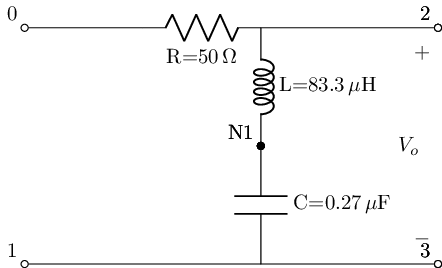
#get this filters abstract transfer function
bandstopRLC_s.get_tf(with_values=False)
#get this filters transfer function
bandstopRLC_s.get_tf(with_values=True)
reset()
#create the nets
net_in=Net('In'); net_out=Net('Out');
#create a 1V AC test source and attache to nets
vs=SINEV(ac_magnitude=1@u_V); vs['p', 'n']+=net_in, gnd
#attaceh term_0 to net_in and term_2 to net_out per scikit-rf convention all
#other terminals are grounded
bandstopRLC_s.SKiDl(net_in, gnd, net_out, gnd)
circ=generate_netlist()
print(circ)
.title
V1 In 0 DC 0V AC 1V 0.0rad SIN(0V 1V 50Hz 0s 0Hz)
L1 Out N_1 8.33e-05H
C1 N_1 0 2.7e-07
R1 In Out 50Ohm
No errors or warnings found during netlist generation.
filter_responce=qfilter_explorer(circ, 'RLC Series Bandstop Filter Responce');
| Start_freq | Stop_Freq | SamplingInc | StepType | |
|---|---|---|---|---|
| 0 | 0.1 Hz | 1 GHz | 20 | decade |
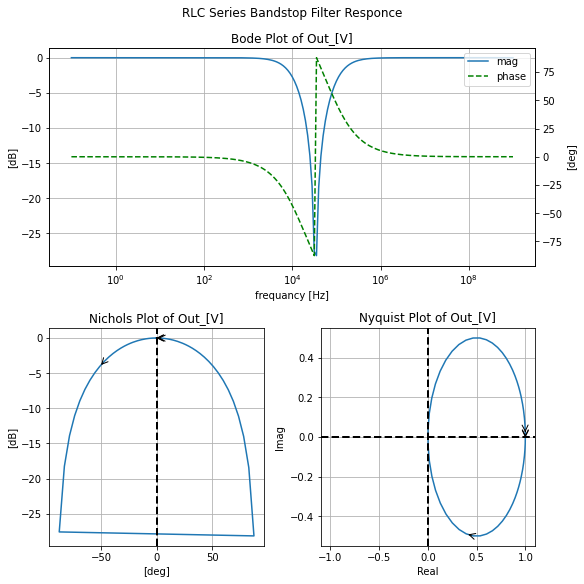
filter_responce.symbolic_tf(bandstopRLC_s)
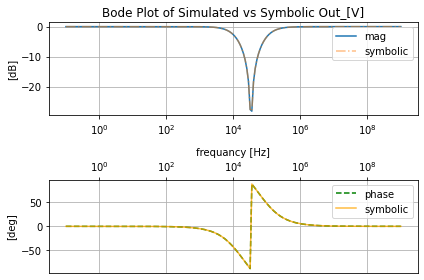
Parallel Based¶¶
V_out, V_in, angfreq_1, angfreq_2, angfreq_0, R_sym, C_sym, L_sym, Q_sym, f_sym, f0_sym, B_sym=sym.symbols('V_{out}, V_{in}, omega_1, omega_2, omega_0, R, C, L, Q, f, f_0, B' )
V_out, V_in, angfreq_1, angfreq_2, angfreq_0, R_sym, C_sym, L_sym, Q_sym, f_sym, f0_sym, B_sym

f1=10.61e3; f2=106.1e3
subs={R_sym:50}
subs[angfreq_1]=2*np.pi*f1; subs[angfreq_2]=2*np.pi*f2
subs[angfreq_0]=np.sqrt(subs[angfreq_1]*subs[angfreq_2])
subs[B_sym]=subs[angfreq_2]-subs[angfreq_1]
subs[Q_sym]=subs[angfreq_0]/subs[B_sym]
subs

Qp_eq=sym.Eq(Q_sym, angfreq_0*R_sym*C_sym); Qp_eq

subs[C_sym]=sym.solve(Qp_eq, C_sym)[0].subs(subs); subs

angfreq_0_eq=sym.Eq(angfreq_0, 1/sym.sqrt(L_sym*C_sym)); angfreq_0_eq

subs[L_sym]=sym.solve(angfreq_0_eq, L_sym)[0].subs(subs); subs

RLC parallel lowpass¶
#%%writefile -a AC_2_Codes.py
#chapteer 2 section 2 rlc_parallel_lowpass filter class
#class with lcapy and skidl subcircuit to create an RLC parallel lowpass filter
class rlc_parallel_lowpass():
"""
holding class for SkiDl subcircuit and lcapy schematic of a
lowpass parallel RLC filter primitive
"""
def __init__(self, subcirc_ref=None, L_value=1@u_H, C_value=1@u_F, R_value=1@u_Ohm):
"""
Args:
subcirc_ref (str): reference to use for the base of the internal elements
L_value (float; 1@u_F; Henerys): the inductance in farads for the RLC inductive element
C_value (float; 1@u_F; Farads): the capacitance in farads for the RLC capacitive element
R_value (float; 1@u_Ohm; Ohms): the resistance in ohms for the RLC resistive element
Returns:
None
TODO:
-add assertions
"""
#add assertions
self.subcirc_ref=subcirc_ref
self.L_value=L_value
self.C_value=C_value
self.R_value=R_value
@subcircuit
def SKiDl(self, term_0, term_1, term_2, term_3, return_elements=False):
"""
Terminals:
term_0, term_1, term_2, term_3
Terminals are defined via:
```
Left_Termanals - RLC_s_Lowpass - Right_Termanals
+----+
Postive V_i term_0-|0 2|-term_2 Postive V_o
Negtive V_i term_1-|1 3|-term_3 Negtive V_o
+----+
```
Args:
return_internls (bool; False): If True return out the internal Voltage Source,
and Resistance objects in this package
Returns:
Returns elements to circuit RLC parallel lowpass filter part element object and if `return_internls`
is True will return the internal voltage and resistance objects in that order
"""
if self.subcirc_ref!=None:
Lref={'ref':f'L_{self.subcirc_ref}'}
Cref={'ref':f'C_{self.subcirc_ref}'}
Rref={'ref':f'R_{self.subcirc_ref}'}
else:
Lref={}
Cref={}
Rref={}
self.l=L(value=self.L_value, **Lref)
self.c=C(value=self.C_value, **Cref)
self.r=R(value=self.R_value, **Rref)
self.l[1, 2]+=term_0, term_2
self.c['p', 'n']+=term_2, term_1
self.r[1, 2]+=term_2, term_3
self.c['n']+=self.r[2]
if return_elements:
return self.c, self.r, self.l
def lcapy_self(self, draw_me=True, with_values=True):
"""
Creates a lcapy schematic of this classes filter that
can be used for amongst other things: draw a basic schematic
of this class filter, extract the transfer function,
exstract the 2Port Repersntation
Args:
draw_me (bool): will draw a schematic of this classes filter schematic
with_values (bool): will push the filters element values into
the resulting lcapy circuit object in place of abstract sympy variables
Return:
the lcapys circuit object is stored in `self.schematic` and will
have abstract sympy variable for the elements if `with_values` is False
and will draw the schematic of just this classes filter if `draw_me` is True
TODO:
- get the Vin statement into the schematic
"""
self.schematic=kiwi.Circuit()
self.schematic.add('W 0 0_1; right')
self.schematic.add('W 1 1_1; right=2')
#self.schematic.add('P1 0 1; down, v=V_i')
self.schematic.add(f'L 0_1 2_2; right')
self.schematic.add(f'C 2_2 1_1; down')
self.schematic.add('W 2_2 2_1; right')
self.schematic.add('W 1_1 3_1; right')
self.schematic.add(f'R 2_1 3_1; down')
self.schematic.add('W 2_1 2; right=1.5')
self.schematic.add('W 3_1 3; right=1.5')
self.schematic.add('P2 2 3; down, v=V_o')
if with_values:
self.schematic=self.schematic.subs({'R':self.R_value, 'L':self.L_value, 'C':self.C_value})
if draw_me:
self.schematic.draw()
def get_tf(self, with_values=True, ZPK=True):
"""
will extract the symbolic transfer function for this filter
Args:
with_values (bool): will push the filters element values into
the resulting lcapy circuit object in place of abstract sympy variables
ZPK (bool): if True will try to return the TF in zero-pole-gain form
else will try to return the TF in canonical form
where the unity coefficient is the highest power of the denominator
"""
self.lcapy_self(draw_me=False, with_values=with_values)
self.tf=self.schematic.transfer(0, 1, 2, 3)
if ZPK:
return self.tf.ZPK()
else:
return self.tf.canonical()
def get_twoPort(self, network_rep='Y', with_values=True):
"""
Gets the 2Port network representation of this filter.
The 2Port representation can be controlled
Args:
network_rep (str; 'Y'): control string for what
representation is used to choose from:
'Z': two-port Z-parameters matrix
'Y': two-port Y-parameters matrix
'H': two-port H-parameters matrix
'G': two-port G-parameters matrix
'ABCD': two-port A-parameters matrix
'invABCD': two-port B-parameters matrix
'S': two-port S-parameters matrix
'T': two-port T-parameters matrix
"""
self.lcapy_self(draw_me=False, with_values=with_values)
#create an action dict to get the 2P rep
rep_actions={
'Z':lambda x: x.Zparams(0, 1, 2, 1),
'Y':lambda x: x.Yparams(0, 1, 2, 1),
'H':lambda x: x.Hparams(0, 1, 2, 1),
'G':lambda x: x.Gparams(0, 1, 2, 1),
'ABCD':lambda x: x.Aparams(0, 1, 2, 1),
'invABCD':lambda x: x.Bparams(0, 1, 2, 1),
'S':lambda x: x.Sparams(0, 1, 2, 1),
'T':lambda x: x.Tparams(0, 1, 2, 1),
}
assert network_rep in rep_actions.keys(), f'`{network_rep}` is not 2Port rep'
return rep_actions[network_rep](self.schematic)
#instatate the rlc_lowpass filter
lowpassRLC_p=rlc_parallel_lowpass(L_value=.0006750@u_H, C_value=3.33e-8@u_F, R_value=50@u_Ohm)
lowpassRLC_p.lcapy_self()

#get this filters abstract transfer function
lowpassRLC_p.get_tf(with_values=False)
#get this filters transfer function
lowpassRLC_p.get_tf(with_values=True)
reset()
#create the nets
net_in=Net('In'); net_out=Net('Out');
#create a 1V AC test source and attache to nets
vs=SINEV(ac_magnitude=1@u_V); vs['p', 'n']+=net_in, gnd
#attaceh term_0 to net_in and term_2 to net_out per scikit-rf convention all
#other terminals are grounded
lowpassRLC_p.SKiDl(net_in, gnd, net_out, gnd)
circ=generate_netlist()
print(circ)
.title
V1 In 0 DC 0V AC 1V 0.0rad SIN(0V 1V 50Hz 0s 0Hz)
L1 In Out 0.000675H
C1 Out 0 3.33e-08
R1 Out 0 50Ohm
No errors or warnings found during netlist generation.
filter_responce=qfilter_explorer(circ, 'RLC Parallel Lowpass Filter Responce');
| Start_freq | Stop_Freq | SamplingInc | StepType | |
|---|---|---|---|---|
| 0 | 0.1 Hz | 1 GHz | 20 | decade |
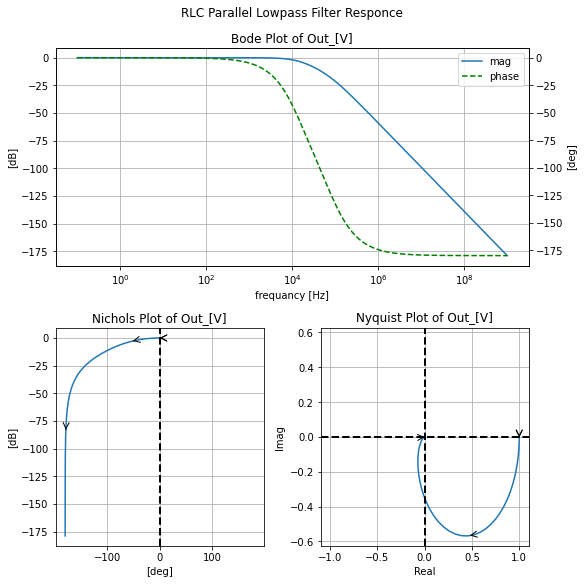
filter_responce.symbolic_tf(lowpassRLC_p)
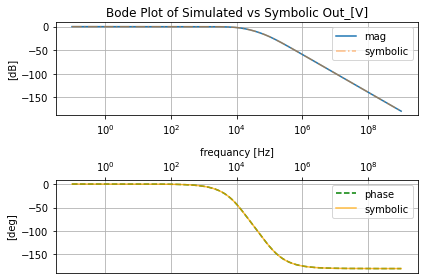
RLC parallel highpass¶
#%%writefile -a AC_2_Codes.py
#chapteer 2 section 2 rlc_parallel_highpass filter class
#class with lcapy and skidl subcircuit to create an RLC parallel highpass filter
class rlc_parallel_highpass():
"""
holding class for SkiDl subcircuit and lcapy schematic of a
highpass parallel RLC filter primitive
"""
def __init__(self, subcirc_ref=None, L_value=1@u_H, C_value=1@u_F, R_value=1@u_Ohm):
"""
Args:
subcirc_ref (str): reference to use for the base of the internal elements
L_value (float; 1@u_F; Henerys): the inductance in farads for the RLC inductive element
C_value (float; 1@u_F; Farads): the capacitance in farads for the RLC capacitive element
R_value (float; 1@u_Ohm; Ohms): the resistance in ohms for the RLC resistive element
Returns:
None
TODO:
-add assertions
"""
#add assertions
self.subcirc_ref=subcirc_ref
self.L_value=L_value
self.C_value=C_value
self.R_value=R_value
@subcircuit
def SKiDl(self, term_0, term_1, term_2, term_3, return_elements=False):
"""
Terminals:
term_0, term_1, term_2, term_3
Terminals are defined via:
```
Left_Termanals - RLC_s_highpass - Right_Termanals
+----+
Postive V_i term_0-|0 2|-term_2 Postive V_o
Negtive V_i term_1-|1 3|-term_3 Negtive V_o
+----+
```
Args:
return_internls (bool; False): If True return out the internal Voltage Source,
and Resistance objects in this package
Returns:
Returns elements to circuit RLC parallel highpass filter part element object and if `return_internls`
is True will return the internal voltage and resistance objects in that order
"""
if self.subcirc_ref!=None:
Lref={'ref':f'L_{self.subcirc_ref}'}
Cref={'ref':f'C_{self.subcirc_ref}'}
Rref={'ref':f'R_{self.subcirc_ref}'}
else:
Lref={}
Cref={}
Rref={}
self.l=L(value=self.L_value, **Lref)
self.c=C(value=self.C_value, **Cref)
self.r=R(value=self.R_value, **Rref)
self.c['p', 'n']+=term_0, term_2
self.r[1, 2]+=term_2, term_1
self.l[1, 2]+=term_2, term_3
self.l[2]+=self.r[2]
if return_elements:
return self.c, self.r, self.l
def lcapy_self(self, draw_me=True, with_values=True):
"""
Creates a lcapy schematic of this classes filter that
can be used for amongst other things: draw a basic schematic
of this class filter, extract the transfer function,
exstract the 2Port Repersntation
Args:
draw_me (bool): will draw a schematic of this classes filter schematic
with_values (bool): will push the filters element values into
the resulting lcapy circuit object in place of abstract sympy variables
Return:
the lcapys circuit object is stored in `self.schematic` and will
have abstract sympy variable for the elements if `with_values` is False
and will draw the schematic of just this classes filter if `draw_me` is True
TODO:
- get the Vin statement into the schematic
"""
self.schematic=kiwi.Circuit()
self.schematic.add('W 0 0_1; right')
self.schematic.add('W 1 1_1; right=2')
#self.schematic.add('P1 0 1; down, v=V_i')
self.schematic.add(f'C 0_1 2_2; right')
self.schematic.add(f'R 2_2 1_1; down')
self.schematic.add('W 2_2 2_1; right')
self.schematic.add('W 1_1 3_1; right')
self.schematic.add(f'L 2_1 3_1; down')
self.schematic.add('W 2_1 2; right=1.5')
self.schematic.add('W 3_1 3; right=1.5')
self.schematic.add('P2 2 3; down, v=V_o')
if with_values:
self.schematic=self.schematic.subs({'R':self.R_value, 'L':self.L_value, 'C':self.C_value})
if draw_me:
self.schematic.draw()
def get_tf(self, with_values=True, ZPK=True):
"""
will extract the symbolic transfer function for this filter
Args:
with_values (bool): will push the filters element values into
the resulting lcapy circuit object in place of abstract sympy variables
ZPK (bool): if True will try to return the TF in zero-pole-gain form
else will try to return the TF in canonical form
where the unity coefficient is the highest power of the denominator
"""
self.lcapy_self(draw_me=False, with_values=with_values)
self.tf=self.schematic.transfer(0, 1, 2, 3)
if ZPK:
return self.tf.ZPK()
else:
return self.tf.canonical()
def get_twoPort(self, network_rep='Y', with_values=True):
"""
Gets the 2Port network representation of this filter.
The 2Port representation can be controlled
Args:
network_rep (str; 'Y'): control string for what
representation is used to choose from:
'Z': two-port Z-parameters matrix
'Y': two-port Y-parameters matrix
'H': two-port H-parameters matrix
'G': two-port G-parameters matrix
'ABCD': two-port A-parameters matrix
'invABCD': two-port B-parameters matrix
'S': two-port S-parameters matrix
'T': two-port T-parameters matrix
"""
self.lcapy_self(draw_me=False, with_values=with_values)
#create an action dict to get the 2P rep
rep_actions={
'Z':lambda x: x.Zparams(0, 1, 2, 1),
'Y':lambda x: x.Yparams(0, 1, 2, 1),
'H':lambda x: x.Hparams(0, 1, 2, 1),
'G':lambda x: x.Gparams(0, 1, 2, 1),
'ABCD':lambda x: x.Aparams(0, 1, 2, 1),
'invABCD':lambda x: x.Bparams(0, 1, 2, 1),
'S':lambda x: x.Sparams(0, 1, 2, 1),
'T':lambda x: x.Tparams(0, 1, 2, 1),
}
assert network_rep in rep_actions.keys(), f'`{network_rep}` is not 2Port rep'
return rep_actions[network_rep](self.schematic)
#instatate the rlc_highpass filter
highpassRLC_p=rlc_parallel_highpass(L_value=.0006750@u_H, C_value=3.33e-8@u_F, R_value=50@u_Ohm)
highpassRLC_p.lcapy_self()

#get this filters abstract transfer function
highpassRLC_p.get_tf(with_values=False)
#get this filters transfer function
highpassRLC_p.get_tf(with_values=True)
reset()
#create the nets
net_in=Net('In'); net_out=Net('Out');
#create a 1V AC test source and attache to nets
vs=SINEV(ac_magnitude=1@u_V); vs['p', 'n']+=net_in, gnd
#attaceh term_0 to net_in and term_2 to net_out per scikit-rf convention all
#other terminals are grounded
highpassRLC_p.SKiDl(net_in, gnd, net_out, gnd)
circ=generate_netlist()
print(circ)
.title
V1 In 0 DC 0V AC 1V 0.0rad SIN(0V 1V 50Hz 0s 0Hz)
L1 Out 0 0.000675H
C1 In Out 3.33e-08
R1 Out 0 50Ohm
No errors or warnings found during netlist generation.
filter_responce=qfilter_explorer(circ, 'RLC Parallel Highpass Filter Responce');
| Start_freq | Stop_Freq | SamplingInc | StepType | |
|---|---|---|---|---|
| 0 | 0.1 Hz | 1 GHz | 20 | decade |

filter_responce.symbolic_tf(highpassRLC_p)
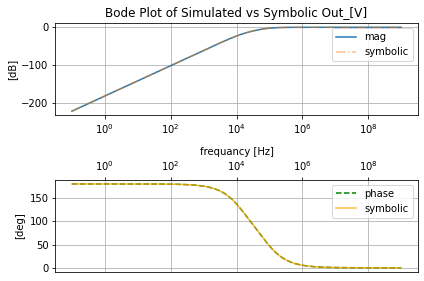
RLC parallel bandpass¶
#%%writefile -a AC_2_Codes.py
#chapteer 2 section 2 rlc_parallel_bandpass filter class
#class with lcapy and skidl subcircuit to create an RLC parallel bandpass filter
class rlc_parallel_bandpass():
"""
holding class for SkiDl subcircuit and lcapy schematic of a
bandpass parallel RLC filter primitive
"""
def __init__(self, subcirc_ref=None, L_value=1@u_H, C_value=1@u_F, R_value=1@u_Ohm):
"""
Args:
subcirc_ref (str): reference to use for the base of the internal elements
L_value (float; 1@u_F; Henerys): the inductance in farads for the RLC inductive element
C_value (float; 1@u_F; Farads): the capacitance in farads for the RLC capacitive element
R_value (float; 1@u_Ohm; Ohms): the resistance in ohms for the RLC resistive element
Returns:
None
TODO:
-add assertions
"""
#add assertions
self.subcirc_ref=subcirc_ref
self.L_value=L_value
self.C_value=C_value
self.R_value=R_value
@subcircuit
def SKiDl(self, term_0, term_1, term_2, term_3, return_elements=False):
"""
Terminals:
term_0, term_1, term_2, term_3
Terminals are defined via:
```
Left_Termanals - RLC_s_bandpass - Right_Termanals
+----+
Postive V_i term_0-|0 2|-term_2 Postive V_o
Negtive V_i term_1-|1 3|-term_3 Negtive V_o
+----+
```
Args:
return_internls (bool; False): If True return out the internal Voltage Source,
and Resistance objects in this package
Returns:
Returns elements to circuit RLC parallel bandpass filter part element object and if `return_internls`
is True will return the internal voltage and resistance objects in that order
"""
if self.subcirc_ref!=None:
Lref={'ref':f'L_{self.subcirc_ref}'}
Cref={'ref':f'C_{self.subcirc_ref}'}
Rref={'ref':f'R_{self.subcirc_ref}'}
else:
Lref={}
Cref={}
Rref={}
self.l=L(value=self.L_value, **Lref)
self.c=C(value=self.C_value, **Cref)
self.r=R(value=self.R_value, **Rref)
self.r[1, 2]+=term_0, term_2
self.c['p', 'n']+=term_2, term_1
self.l[1, 2]+=term_2, term_3
self.l[2]+=self.c['n']
if return_elements:
return self.c, self.r, self.l
def lcapy_self(self, draw_me=True, with_values=True):
"""
Creates a lcapy schematic of this classes filter that
can be used for amongst other things: draw a basic schematic
of this class filter, extract the transfer function,
exstract the 2Port Repersntation
Args:
draw_me (bool): will draw a schematic of this classes filter schematic
with_values (bool): will push the filters element values into
the resulting lcapy circuit object in place of abstract sympy variables
Return:
the lcapys circuit object is stored in `self.schematic` and will
have abstract sympy variable for the elements if `with_values` is False
and will draw the schematic of just this classes filter if `draw_me` is True
TODO:
- get the Vin statement into the schematic
"""
self.schematic=kiwi.Circuit()
self.schematic.add('W 0 0_1; right')
self.schematic.add('W 1 1_1; right=2')
#self.schematic.add('P1 0 1; down, v=V_i')
self.schematic.add(f'R 0_1 2_2; right')
self.schematic.add(f'C 2_2 1_1; down')
self.schematic.add('W 2_2 2_1; right')
self.schematic.add('W 1_1 3_1; right')
self.schematic.add(f'L 2_1 3_1; down')
self.schematic.add('W 2_1 2; right=1.5')
self.schematic.add('W 3_1 3; right=1.5')
self.schematic.add('P2 2 3; down, v=V_o')
if with_values:
self.schematic=self.schematic.subs({'R':self.R_value, 'L':self.L_value, 'C':self.C_value})
if draw_me:
self.schematic.draw()
def get_tf(self, with_values=True, ZPK=True):
"""
will extract the symbolic transfer function for this filter
Args:
with_values (bool): will push the filters element values into
the resulting lcapy circuit object in place of abstract sympy variables
ZPK (bool): if True will try to return the TF in zero-pole-gain form
else will try to return the TF in canonical form
where the unity coefficient is the highest power of the denominator
"""
self.lcapy_self(draw_me=False, with_values=with_values)
self.tf=self.schematic.transfer(0, 1, 2, 3)
if ZPK:
return self.tf.ZPK()
else:
return self.tf.canonical()
def get_twoPort(self, network_rep='Y', with_values=True):
"""
Gets the 2Port network representation of this filter.
The 2Port representation can be controlled
Args:
network_rep (str; 'Y'): control string for what
representation is used to choose from:
'Z': two-port Z-parameters matrix
'Y': two-port Y-parameters matrix
'H': two-port H-parameters matrix
'G': two-port G-parameters matrix
'ABCD': two-port A-parameters matrix
'invABCD': two-port B-parameters matrix
'S': two-port S-parameters matrix
'T': two-port T-parameters matrix
"""
self.lcapy_self(draw_me=False, with_values=with_values)
#create an action dict to get the 2P rep
rep_actions={
'Z':lambda x: x.Zparams(0, 1, 2, 1),
'Y':lambda x: x.Yparams(0, 1, 2, 1),
'H':lambda x: x.Hparams(0, 1, 2, 1),
'G':lambda x: x.Gparams(0, 1, 2, 1),
'ABCD':lambda x: x.Aparams(0, 1, 2, 1),
'invABCD':lambda x: x.Bparams(0, 1, 2, 1),
'S':lambda x: x.Sparams(0, 1, 2, 1),
'T':lambda x: x.Tparams(0, 1, 2, 1),
}
assert network_rep in rep_actions.keys(), f'`{network_rep}` is not 2Port rep'
return rep_actions[network_rep](self.schematic)
#instatate the rlc_bandpass filter
bandpassRLC_p=rlc_parallel_bandpass(L_value=.0006750@u_H, C_value=3.33e-8@u_F, R_value=50@u_Ohm)
bandpassRLC_p.lcapy_self()

#get this filters abstract transfer function
bandpassRLC_p.get_tf(with_values=False)
#get this filters transfer function
bandpassRLC_p.get_tf(with_values=True)
reset()
#create the nets
net_in=Net('In'); net_out=Net('Out');
#create a 1V AC test source and attache to nets
vs=SINEV(ac_magnitude=1@u_V); vs['p', 'n']+=net_in, gnd
#attaceh term_0 to net_in and term_2 to net_out per scikit-rf convention all
#other terminals are grounded
bandpassRLC_p.SKiDl(net_in, gnd, net_out, gnd)
circ=generate_netlist()
print(circ)
.title
V1 In 0 DC 0V AC 1V 0.0rad SIN(0V 1V 50Hz 0s 0Hz)
L1 Out 0 0.000675H
C1 Out 0 3.33e-08
R1 In Out 50Ohm
No errors or warnings found during netlist generation.
filter_responce=qfilter_explorer(circ, 'RLC Parallel Bandpass Filter Responce');
| Start_freq | Stop_Freq | SamplingInc | StepType | |
|---|---|---|---|---|
| 0 | 0.1 Hz | 1 GHz | 20 | decade |
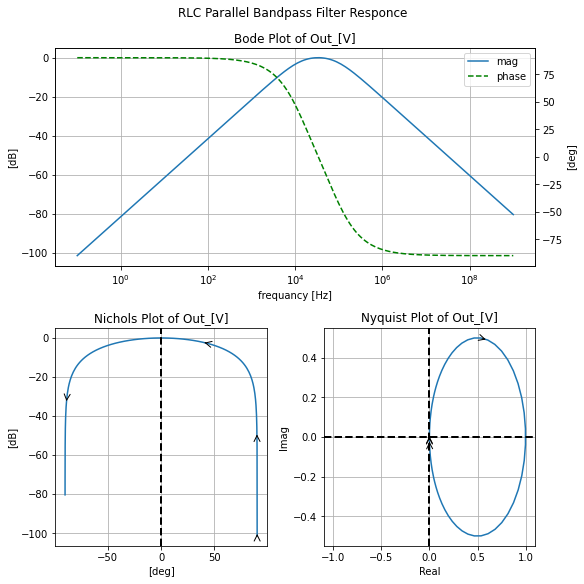
filter_responce.symbolic_tf(bandpassRLC_p)
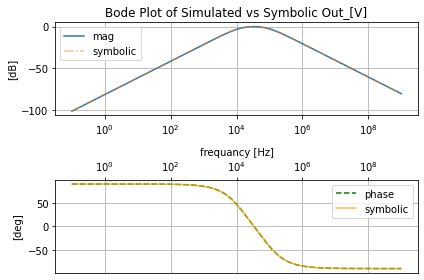
RLC parallel bandstop¶
#%%writefile -a AC_2_Codes.py
#chapteer 2 section 2 rlc_parallel_bandstop filter class
#class with lcapy and skidl subcircuit to create an RLC parallel bandstop filter
class rlc_parallel_bandstop():
"""
holding class for SkiDl subcircuit and lcapy schematic of a
bandstop parallel RLC filter primitive
"""
def __init__(self, subcirc_ref=None, L_value=1@u_H, C_value=1@u_F, R_value=1@u_Ohm):
"""
Args:
subcirc_ref (str): reference to use for the base of the internal elements
L_value (float; 1@u_F; Henerys): the inductance in farads for the RLC inductive element
C_value (float; 1@u_F; Farads): the capacitance in farads for the RLC capacitive element
R_value (float; 1@u_Ohm; Ohms): the resistance in ohms for the RLC resistive element
Returns:
None
TODO:
-add assertions
"""
#add assertions
self.subcirc_ref=subcirc_ref
self.L_value=L_value
self.C_value=C_value
self.R_value=R_value
@subcircuit
def SKiDl(self, term_0, term_1, term_2, term_3, return_elements=False):
"""
Terminals:
term_0, term_1, term_2, term_3
Terminals are defined via:
```
Left_Termanals - RLC_s_bandstop - Right_Termanals
+----+
Postive V_i term_0-|0 2|-term_2 Postive V_o
Negtive V_i term_1-|1 3|-term_3 Negtive V_o
+----+
```
Args:
return_internls (bool; False): If True return out the internal Voltage Source,
and Resistance objects in this package
Returns:
Returns elements to circuit RLC parallel bandstop filter part element object and if `return_internls`
is True will return the internal voltage and resistance objects in that order
"""
if self.subcirc_ref!=None:
Lref={'ref':f'L_{self.subcirc_ref}'}
Cref={'ref':f'C_{self.subcirc_ref}'}
Rref={'ref':f'R_{self.subcirc_ref}'}
else:
Lref={}
Cref={}
Rref={}
self.l=L(value=self.L_value, **Lref)
self.c=C(value=self.C_value, **Cref)
self.r=R(value=self.R_value, **Rref)
self.c['p', 'n']+=term_0, term_2
self.l[1, 2]+=term_0, term_2
self.r[1, 2]+=term_2, term_3
self.r[2]+=term_1
if return_elements:
return self.c, self.r, self.l
def lcapy_self(self, draw_me=True, with_values=True):
"""
Creates a lcapy schematic of this classes filter that
can be used for amongst other things: draw a basic schematic
of this class filter, extract the transfer function,
exstract the 2Port Repersntation
Args:
draw_me (bool): will draw a schematic of this classes filter schematic
with_values (bool): will push the filters element values into
the resulting lcapy circuit object in place of abstract sympy variables
Return:
the lcapys circuit object is stored in `self.schematic` and will
have abstract sympy variable for the elements if `with_values` is False
and will draw the schematic of just this classes filter if `draw_me` is True
TODO:
- get the Vin statement into the schematic
"""
self.schematic=kiwi.Circuit()
self.schematic.add('W 0 0_1; right')
self.schematic.add('W 1 3_1; right=3.5')
#self.schematic.add('P1 0 1; down, v=V_i')
self.schematic.add('W 0_1, 0_2; up=.3')
self.schematic.add(f'L 0_2 2_3; right')
self.schematic.add('W 2_3 2_2; down=.3')
self.schematic.add('W 0_1, 0_3; down=.3')
self.schematic.add(f'C 0_3 2_4; right')
self.schematic.add('W 2_4 2_2; up=.3')
self.schematic.add(f'R 2_1 3_1; down')
self.schematic.add('W 2_2 2_1; right')
self.schematic.add('W 2_1 2; right')
self.schematic.add('W 3_1 3; right')
self.schematic.add('P2 2 3; down, v=V_o')
if with_values:
self.schematic=self.schematic.subs({'R':self.R_value, 'L':self.L_value, 'C':self.C_value})
if draw_me:
self.schematic.draw()
def get_tf(self, with_values=True, ZPK=True):
"""
will extract the symbolic transfer function for this filter
Args:
with_values (bool): will push the filters element values into
the resulting lcapy circuit object in place of abstract sympy variables
ZPK (bool): if True will try to return the TF in zero-pole-gain form
else will try to return the TF in canonical form
where the unity coefficient is the highest power of the denominator
"""
self.lcapy_self(draw_me=False, with_values=with_values)
self.tf=self.schematic.transfer(0, 1, 2, 3)
if ZPK:
return self.tf.ZPK()
else:
return self.tf.canonical()
def get_twoPort(self, network_rep='Y', with_values=True):
"""
Gets the 2Port network representation of this filter.
The 2Port representation can be controlled
Args:
network_rep (str; 'Y'): control string for what
representation is used to choose from:
'Z': two-port Z-parameters matrix
'Y': two-port Y-parameters matrix
'H': two-port H-parameters matrix
'G': two-port G-parameters matrix
'ABCD': two-port A-parameters matrix
'invABCD': two-port B-parameters matrix
'S': two-port S-parameters matrix
'T': two-port T-parameters matrix
"""
self.lcapy_self(draw_me=False, with_values=with_values)
#create an action dict to get the 2P rep
rep_actions={
'Z':lambda x: x.Zparams(0, 1, 2, 1),
'Y':lambda x: x.Yparams(0, 1, 2, 1),
'H':lambda x: x.Hparams(0, 1, 2, 1),
'G':lambda x: x.Gparams(0, 1, 2, 1),
'ABCD':lambda x: x.Aparams(0, 1, 2, 1),
'invABCD':lambda x: x.Bparams(0, 1, 2, 1),
'S':lambda x: x.Sparams(0, 1, 2, 1),
'T':lambda x: x.Tparams(0, 1, 2, 1),
}
assert network_rep in rep_actions.keys(), f'`{network_rep}` is not 2Port rep'
return rep_actions[network_rep](self.schematic)
#instatate the rc_bandpass filter to
bandstopRLC_p=rlc_parallel_bandstop(L_value=.0006750@u_H, C_value=3.33e-8@u_F, R_value=50@u_Ohm)
bandstopRLC_p.lcapy_self()

#get this filters abstract transfer function
bandstopRLC_p.get_tf(with_values=False)
#get this filters transfer function
bandstopRLC_p.get_tf(with_values=True)
reset()
#create the nets
net_in=Net('In'); net_out=Net('Out');
#create a 1V AC test source and attache to nets
vs=SINEV(ac_magnitude=1@u_V); vs['p', 'n']+=net_in, gnd
#attaceh term_0 to net_in and term_2 to net_out per scikit-rf convention all
#other terminals are grounded
bandstopRLC_p.SKiDl(net_in, gnd, net_out, gnd)
circ=generate_netlist()
print(circ)
.title
V1 In 0 DC 0V AC 1V 0.0rad SIN(0V 1V 50Hz 0s 0Hz)
L1 In Out 0.000675H
C1 In Out 3.33e-08
R1 Out 0 50Ohm
No errors or warnings found during netlist generation.
filter_responce=qfilter_explorer(circ, 'RLC Parallel Bandstop Filter Responce');
| Start_freq | Stop_Freq | SamplingInc | StepType | |
|---|---|---|---|---|
| 0 | 0.1 Hz | 1 GHz | 20 | decade |

filter_responce.symbolic_tf(bandstopRLC_p)
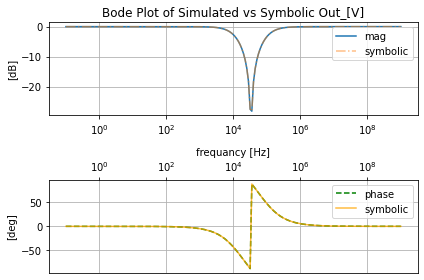
All Pass filters¶
The naming of filters as has been seen is based on the shape of the Bode Magnitude Plot and for the most part, Phase has kind of been a ride along part of the filter design. Stating that, the name for an All-Pass filter is misleading; the better name is a Phase Shaping filter. These Filters ideally do not affect the magnitude of the signal passed through them and instead affect the phase. Here we will look at the lattice All-Pass filter for the low-frequency phase from the following Wikipedia article
https://en.wikipedia.org/wiki/Lattice_phase_equaliser
#%%writefile -a AC_2_Codes.py
#chapteer 2 section 2 lc_balanced_allpass_lowfreq_lattice_filt filter class
#class with lcapy and skidl subcircuit to create an lc all-pass filter
class lc_balanced_allpass_lowfreq_lattice_filt():
"""
holding class for SkiDl subcircuit and lcapy schematic of a
bandstop parallel RLC filter primitive
"""
def __init__(self, subcirc_ref=None, L1_value=1@u_H, L2_value=1@u_H, C1_value=1@u_F, C2_value=1@u_F):
"""
Args:
subcirc_ref (str): reference to use for the base of the internal elements
L1_value (float; 1@u_F; Henerys): the inductance in farads for the top inductive element
L2_value (float; 1@u_F; Henerys): the inductance in farads for the bottom inductive element
C1_value (float; 1@u_F; Farads): the capacitance in farads for the term 2 to term 1 capacitive element
C2_value (float; 1@u_F; Farads): the capacitance in farads for the term 0 to term 2 capacitive element
Returns:
None
TODO:
-add assertions
"""
#add assertions
self.subcirc_ref=subcirc_ref
self.L1_value=L1_value
self.L2_value=L2_value
self.C1_value=C1_value
self.C2_value=C2_value
@subcircuit
def SKiDl(self, term_0, term_1, term_2, term_3, return_elements=False):
"""
Terminals:
term_0, term_1, term_2, term_3
Terminals are defined via:
```
Left_Termanals - RLC_s_bandstop - Right_Termanals
+----+
Postive V_i term_0-|0 2|-term_2 Postive V_o
Negtive V_i term_1-|1 3|-term_3 Negtive V_o
+----+
```
Args:
return_internls (bool; False): If True return out the internal Voltage Source,
and Resistance objects in this package
Returns:
Returns elements to circuit RLC parallel bandstop filter part element object and if `return_internls`
is True will return the internal voltage and resistance objects in that order
"""
if self.subcirc_ref!=None:
L1ref={'ref':f'L_{self.subcirc_ref}1'}
L2ref={'ref':f'L_{self.subcirc_ref}2'}
C1ref={'ref':f'C_{self.subcirc_ref}1'}
C2ref={'ref':f'C_{self.subcirc_ref}2'}
else:
L1ref={}
L2ref={}
C1ref={}
C2ref={}
self.l1=L(value=self.L1_value, **L1ref)
self.l2=L(value=self.L2_value, **L2ref)
self.c1=C(value=self.C1_value, **C1ref)
self.c2=C(value=self.C2_value, **C2ref)
term_0+=self.l1[1], self.c2['p']
term_1+=self.l2[1], self.c1['n']
term_2+=self.l1[2], self.c1['p']
term_3+=self.l2[2], self.c2['n']
if return_elements:
return self.c, self.r, self.l
def lcapy_self(self, draw_me=True, with_values=True):
"""
Creates a lcapy schematic of this classes filter that
can be used for amongst other things: draw a basic schematic
of this class filter, extract the transfer function,
exstract the 2Port Repersntation
Args:
draw_me (bool): will draw a schematic of this classes filter schematic
with_values (bool): will push the filters element values into
the resulting lcapy circuit object in place of abstract sympy variables
Return:
the lcapys circuit object is stored in `self.schematic` and will
have abstract sympy variable for the elements if `with_values` is False
and will draw the schematic of just this classes filter if `draw_me` is True
TODO:
- must draw this better
- get the Vin statement into the schematic
"""
self.schematic=kiwi.Circuit()
self.schematic=kiwi.Circuit()
#self.schematic.add('W 0 0; right')
#self.schematic.add('W 1 3; right=3.5')
#self.schematic.add('P1 0 1; down, v=V_i')
#It ant pretty but it works
self.schematic.add('W 0 0_3; right')
self.schematic.add(f'L1 0_3 2_2; right')
self.schematic.add('W 2_2 2; right')
self.schematic.add('W 0 0_2; rotate=-45')
self.schematic.add(f'C2 0_2 3; rotate=-45')
self.schematic.add(f'C1 2 1_2; rotate=225')
self.schematic.add(f'W 1_2 1; rotate=225')
self.schematic.add('W 1 1_3; right')
self.schematic.add(f'L2 1_3 3_2; right=2')
self.schematic.add('W 3_2 3; right')
if with_values:
self.schematic=self.schematic.subs({'L1':self.L1_value, 'L2':self.L2_value,
'C1':self.C1_value, 'C2':self.C2_value})
if draw_me:
self.schematic.draw()
def get_tf(self, with_values=True, ZPK=True):
"""
will extract the symbolic transfer function for this filter
Args:
with_values (bool): will push the filters element values into
the resulting lcapy circuit object in place of abstract sympy variables
ZPK (bool): if True will try to return the TF in zero-pole-gain form
else will try to return the TF in canonical form
where the unity coefficient is the highest power of the denominator
"""
self.lcapy_self(draw_me=False, with_values=with_values)
self.tf=self.schematic.transfer(0, 1, 2, 3)
if ZPK:
return self.tf.ZPK()
else:
return self.tf.canonical()
def get_twoPort(self, network_rep='Y', with_values=True):
"""
Gets the 2Port network representation of this filter.
The 2Port representation can be controlled
Args:
network_rep (str; 'Y'): control string for what
representation is used to choose from:
'Z': two-port Z-parameters matrix
'Y': two-port Y-parameters matrix
'H': two-port H-parameters matrix
'G': two-port G-parameters matrix
'ABCD': two-port A-parameters matrix
'invABCD': two-port B-parameters matrix
'S': two-port S-parameters matrix
'T': two-port T-parameters matrix
"""
self.lcapy_self(draw_me=False, with_values=with_values)
#create an action dict to get the 2P rep
rep_actions={
'Z':lambda x: x.Zparams(0, 1, 2, 1),
'Y':lambda x: x.Yparams(0, 1, 2, 1),
'H':lambda x: x.Hparams(0, 1, 2, 1),
'G':lambda x: x.Gparams(0, 1, 2, 1),
'ABCD':lambda x: x.Aparams(0, 1, 2, 1),
'invABCD':lambda x: x.Bparams(0, 1, 2, 1),
'S':lambda x: x.Sparams(0, 1, 2, 1),
'T':lambda x: x.Tparams(0, 1, 2, 1),
}
assert network_rep in rep_actions.keys(), f'`{network_rep}` is not 2Port rep'
return rep_actions[network_rep](self.schematic)
If you’re wondering what a lattice filter is, the fact of the matter is that you have seen them before in terms of bridge circuits. See the following Wikipedia article on Lattice Networks
https://www.eeeguide.com/wp-content/uploads/2019/11/Lattice-Network.jpg
#instatate the allpass latice filter to
allpasslat_lf=lc_balanced_allpass_lowfreq_lattice_filt()
allpasslat_lf.lcapy_self()
Distance conflict 0.2761423749153966 vs 1.0 in horizontal graph for WWanon2 between nodes (2_2) and (2), due to incompatible sizes
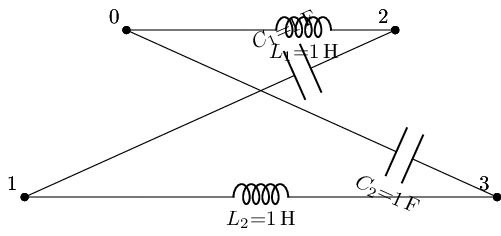
#get this filters abstract transfer function
allpasslat_lf.get_tf(with_values=False)
#get this filters transfer function
allpasslat_lf.get_tf(with_values=True)
reset()
#create the nets; the last one is needed to deal with singularity issues when dealing with lattice circuits and ground
net_in=Net('In'); net_out=Net('Out'); net_outlower=Net('Out2')
#create a 1V AC test source and attache to nets
vs=SINEV(ac_magnitude=1@u_V); vs['p', 'n']+=net_in, gnd
#net_in+=dummy_1[2]
#attaceh term_0 to net_in and term_2 to net_out per scikit-rf convention all
#other terminals are grounded
#but need to add dummy resistors to deal with singular issues and get solvable matric
dummy_botin=R(value=0, ref='dummy')
dummy_botin[1]+=gnd
dummy_botout=R(value=0, ref='dummy')
dummy_botout[2]+=gnd
allpasslat_lf.SKiDl(net_in, dummy_botin[2], net_out, dummy_botout[1])
circ=generate_netlist()
print(circ)
.title
V1 In 0 DC 0V AC 1V 0.0rad SIN(0V 1V 50Hz 0s 0Hz)
Rdummy 0 N_1 0
Rdummy_1 N_2 0 0
L1 In Out 1H
L2 N_1 N_2 1H
C1 Out N_1 1
C2 In N_2 1
No errors or warnings found during netlist generation.
The dummy_bot* resistors that are in the simulation are needed in order for SPICE to no longer throw a singular matrix error. Where the test circuit is drawn below. This might not be needed if the output (terminal 3) of the lattice filter was allowed to float. Floating circuits will be discussed in the next section on transformers in detail. Here all inputs and outputs will be referenced to ground.
lat_testcir=kiwi.Circuit()
lat_testcir.add('Vs In 0; down')
lat_testcir.add('W 0 0_1; down=0.2, sground')
lat_testcir.add('W In U1.l1; right')
lat_testcir.add('Rdummy 0 U1.l2; right, l=0Ohm')
lat_testcir.add('U1 chip2121; right, l={latice}, pinlabels={l1=0,l2=1, r1=2,r2=3}')
lat_testcir.add('W U1.r1 Out; right')
lat_testcir.add('Rdummy_1 U1.r2 Out2; right, l=0Ohm')
lat_testcir.add('W Out2 Out2_1; down=0.2, sground')
lat_testcir.draw()
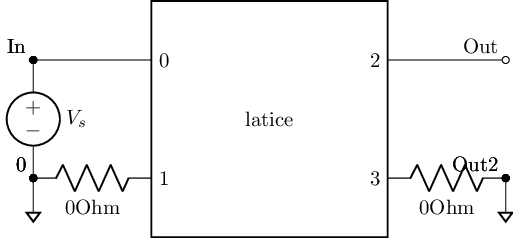
filter_responce=qfilter_explorer(circ, 'LC All-Pass Low Frequcy Lattice Filter');
| Start_freq | Stop_Freq | SamplingInc | StepType | |
|---|---|---|---|---|
| 0 | 0.1 Hz | 1 GHz | 20 | decade |

filter_responce.symbolic_tf(allpasslat_lf)
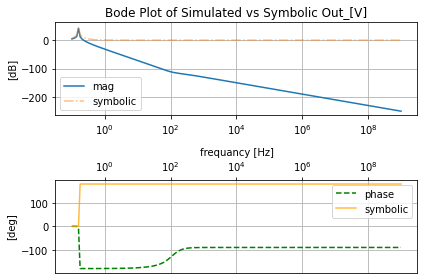
The reason it’s diverging and more specifically flipped in phase might be due to how lcapy is treating the 0 as ground when it formulates the modified nodal analysis. As seen below with the lack of a V_3 term. Going to pass on fixing this right now but it is top of the TODO list for this section
allpasslat_lf.lcapy_self(False, False)
#also wont convert to laplace
n=kiwi.NodalAnalysis(allpasslat_lf.schematic)
n.nodal_equations()
Citations:¶
[1] ALL ABOUT ELECTRONICS. “RC Low Pass Filter Explained,” YouTube, Aug 20, 2017. [Video file]. Available: https://youtu.be/_2L0l-E1Wx0. [Accessed: Nov 30, 2020].
[2] ALL ABOUT ELECTRONICS. “RC High Pass Filter Explained,” YouTube, Aug 23, 2017. [Video file]. Available: https://youtu.be/9Dx0b0ukNAM. [Accessed: Nov 30, 2020].
[3] ALL ABOUT ELECTRONICS. “Band Pass Filter and Band Stop Filter Explained,” YouTube, Sep 2, 2017. [Video file]. Available: https://youtu.be/dmPIydL0lyM. [Accessed: Nov 30, 2020].
[4] S. Makarov, R. Ludwig and S. Bitar, Practical electrical engineering. Cham: Springer International Publishing, 2016, pp. 514-515.
[5] “Lattice phase equaliser”, En.wikipedia.org, 2021. [Online]. Available: https://en.wikipedia.org/wiki/Lattice_phase_equaliser. [Accessed: 10- Jan- 2021].
[6] “Lattice network”, En.wikipedia.org, 2021. [Online]. Available: https://en.wikipedia.org/wiki/Lattice_network. [Accessed: 10- Jan- 2021].